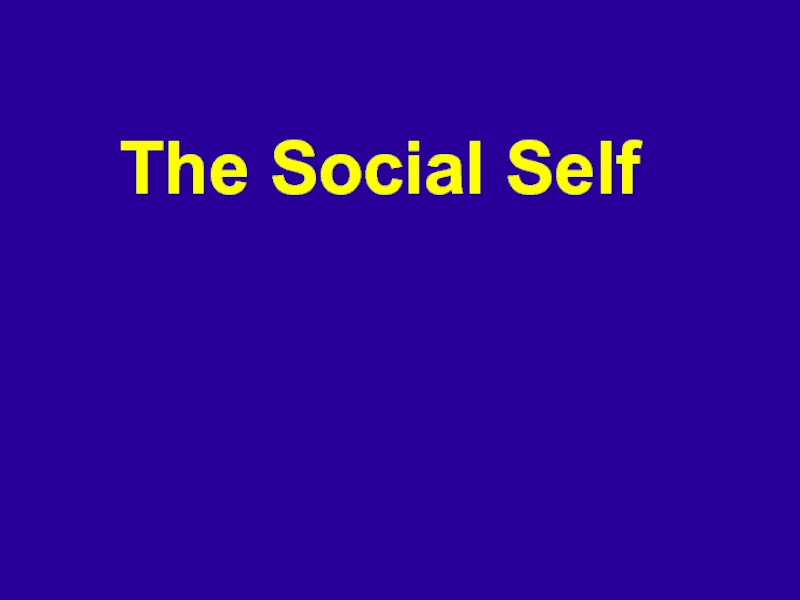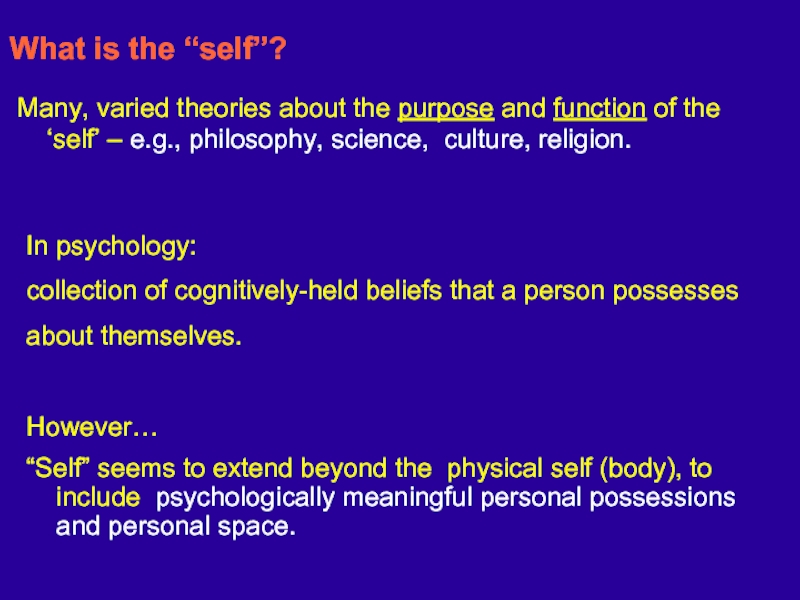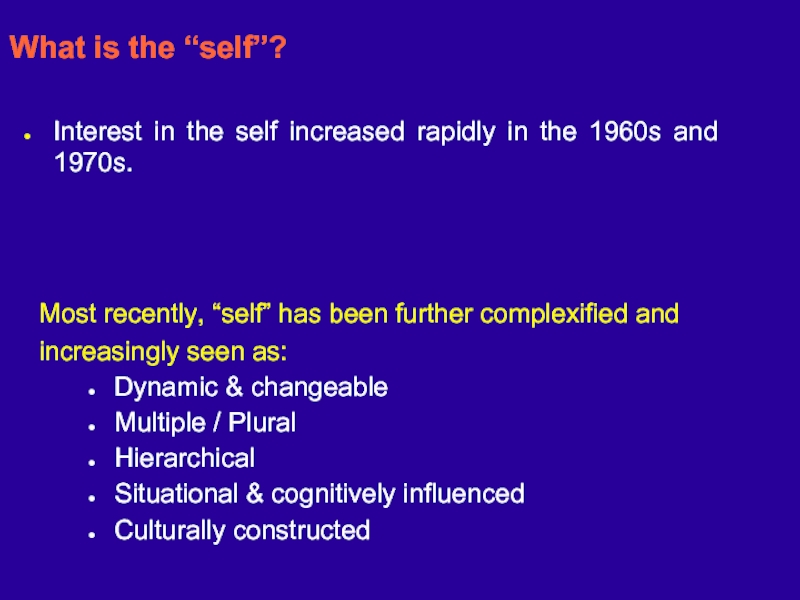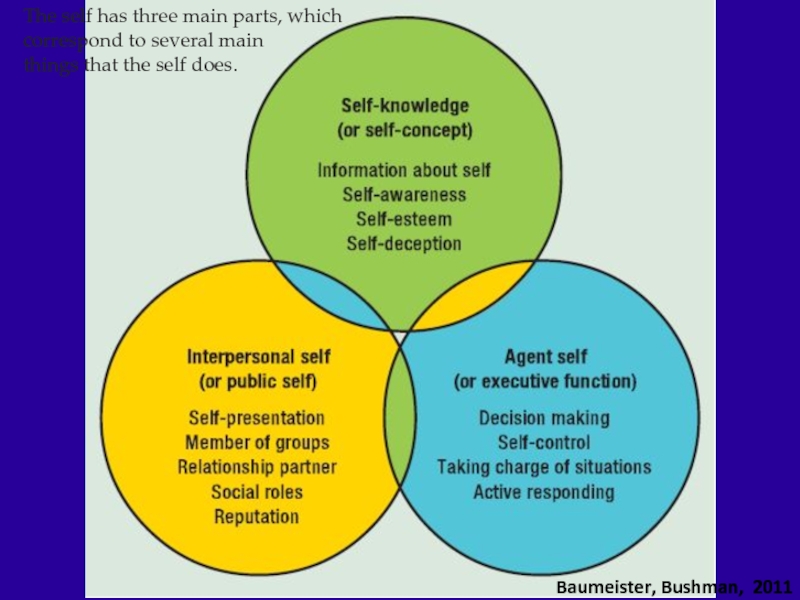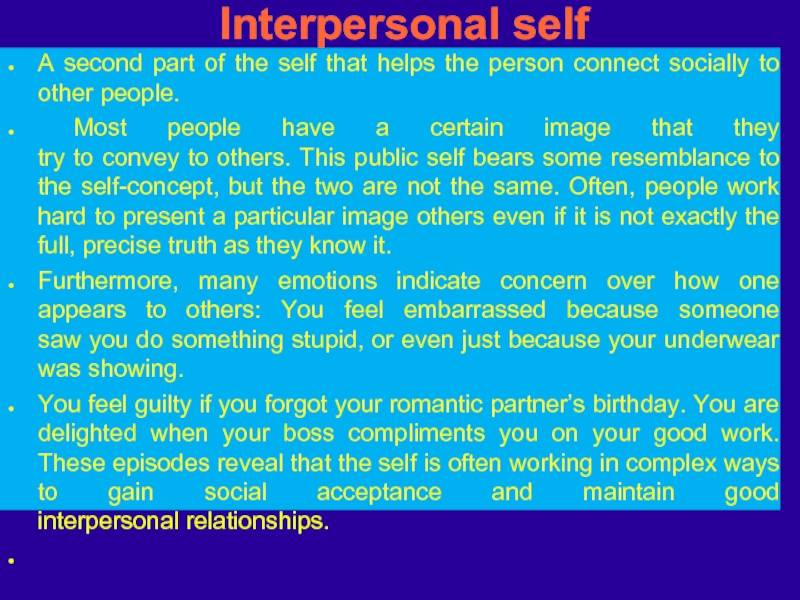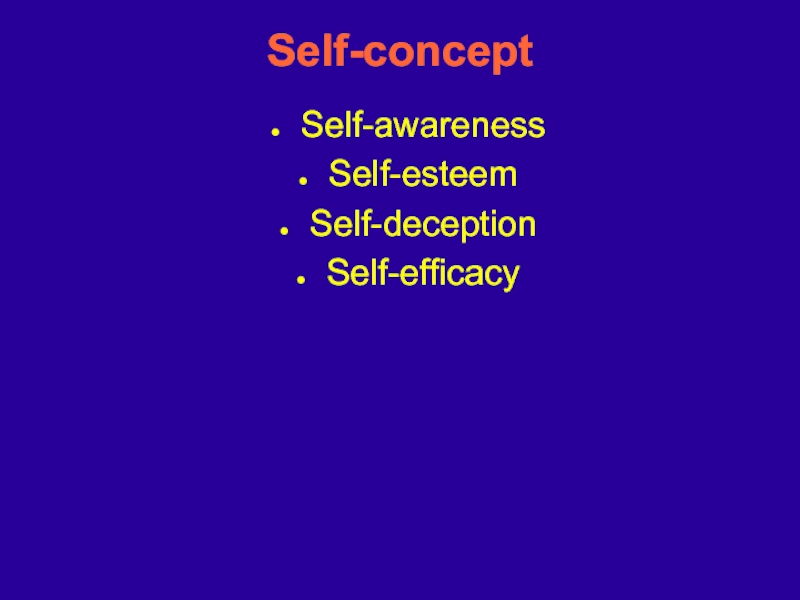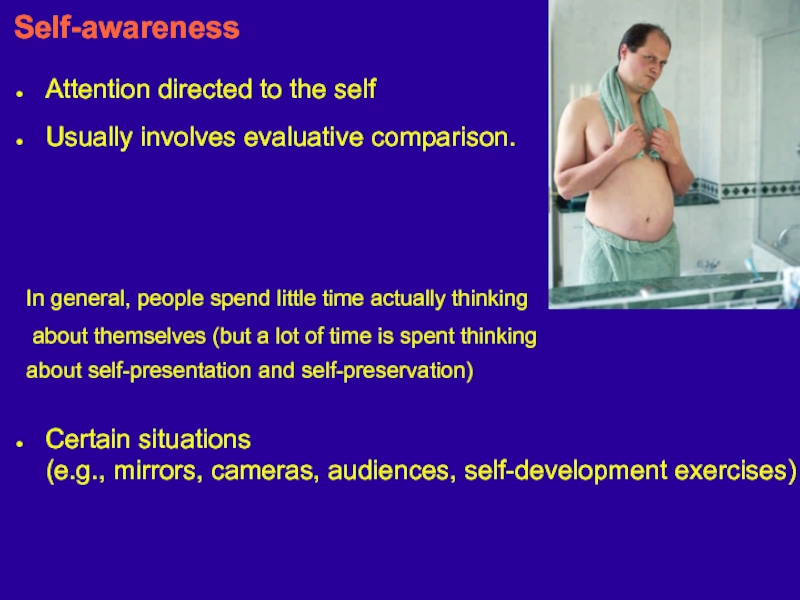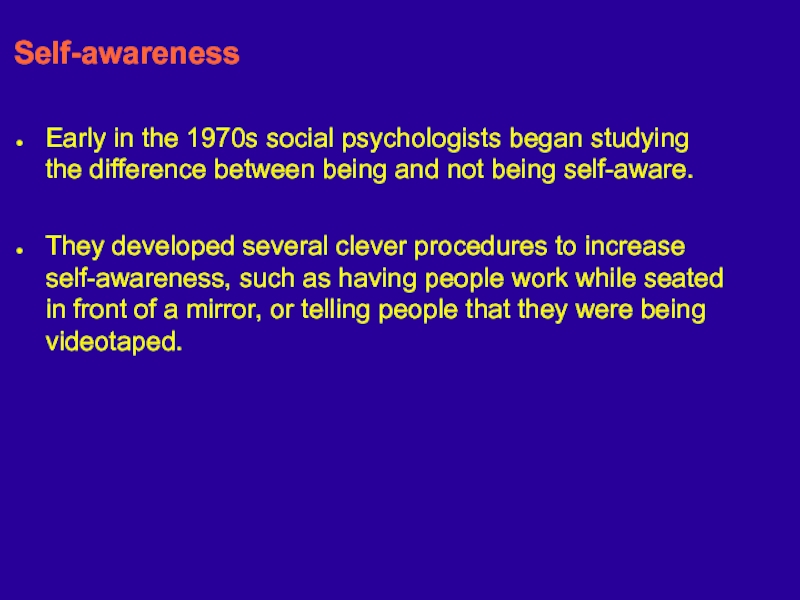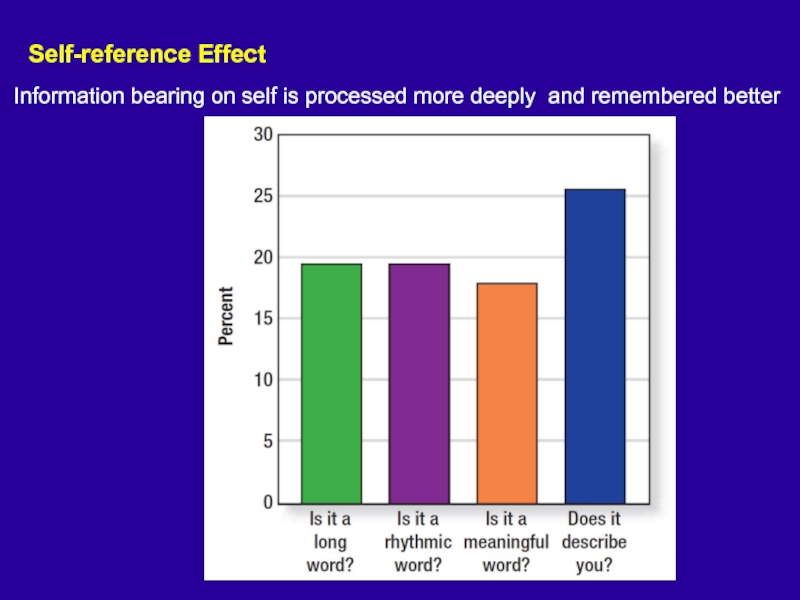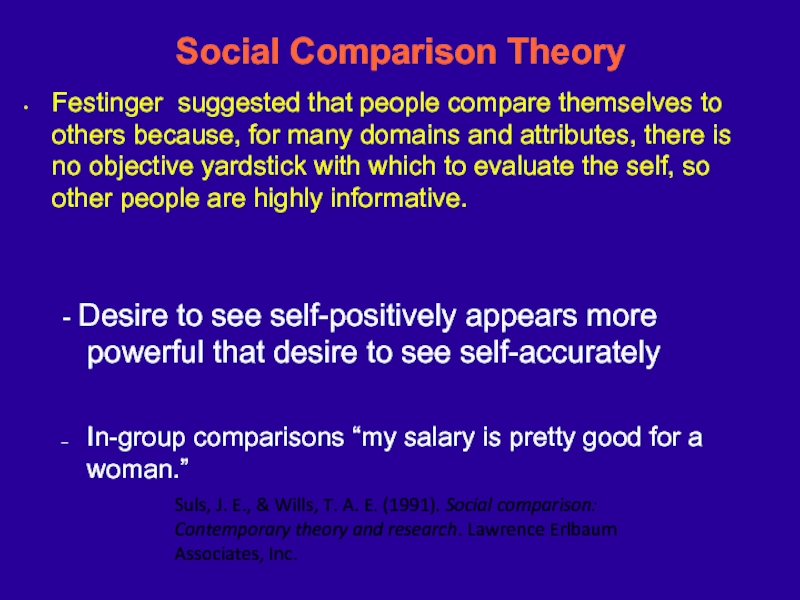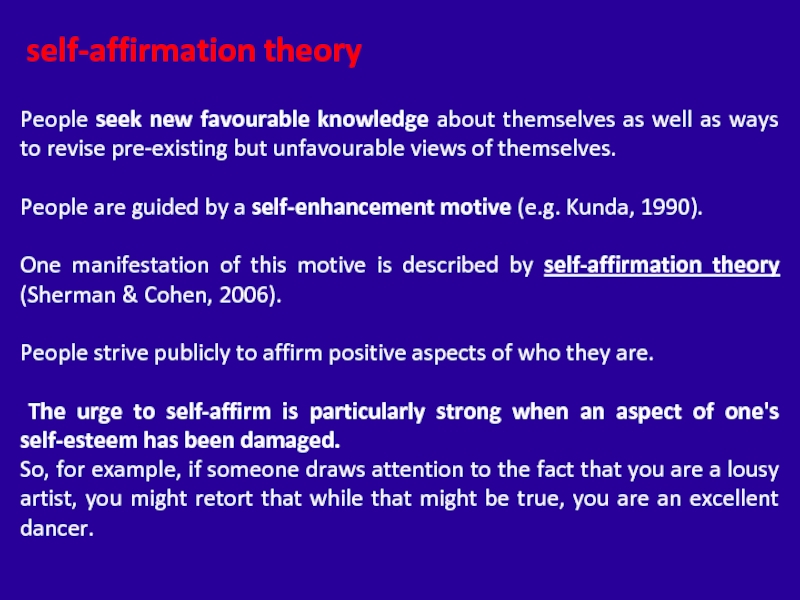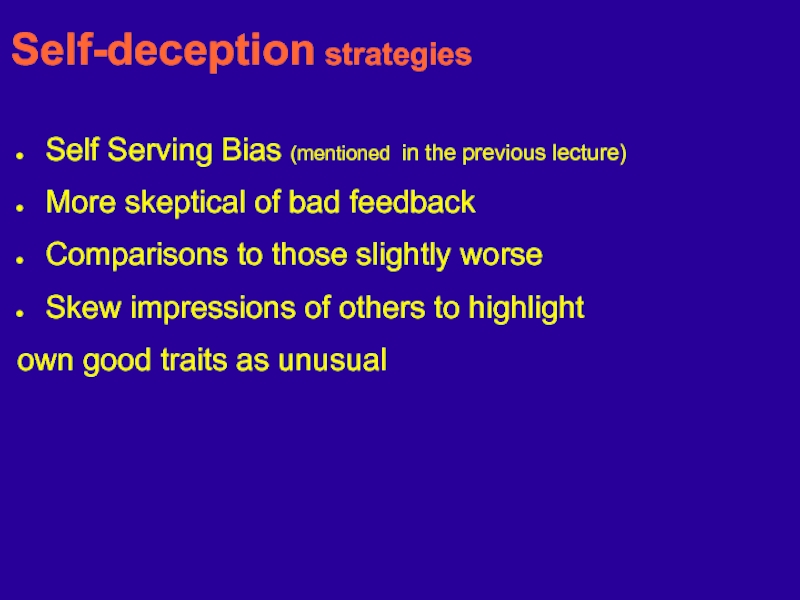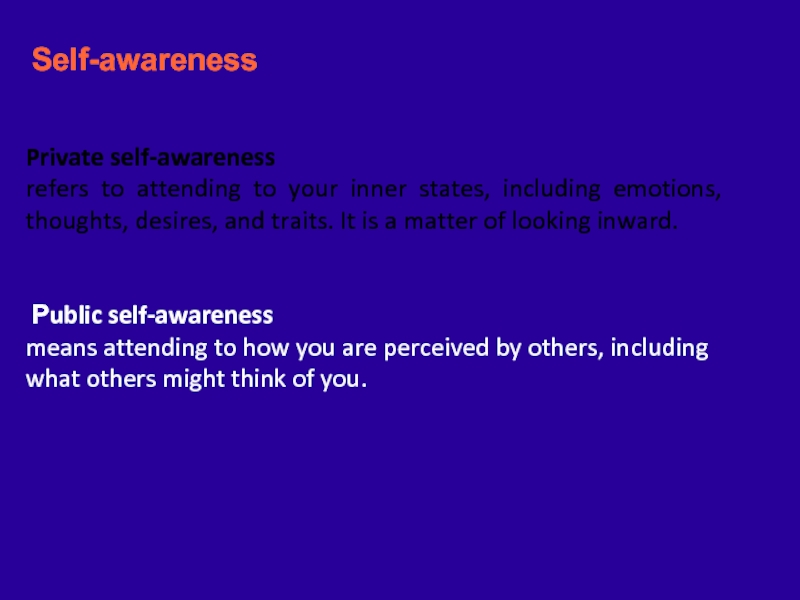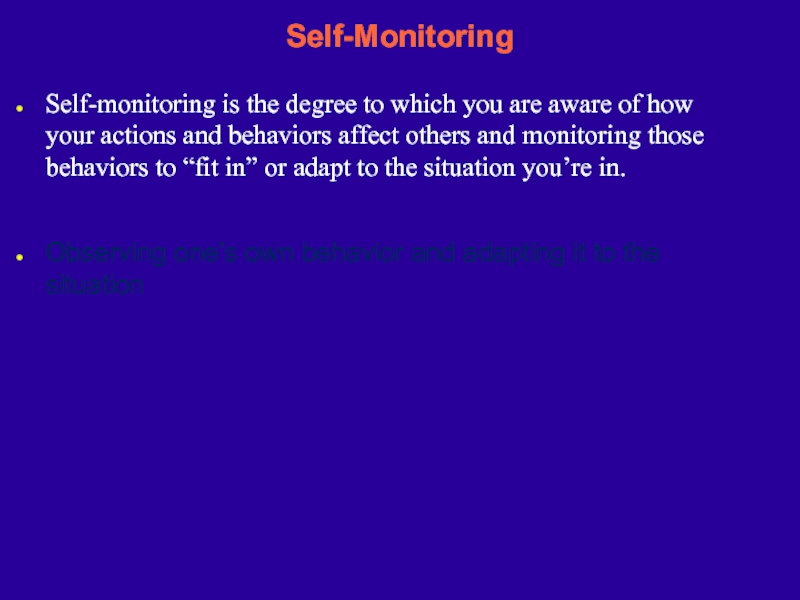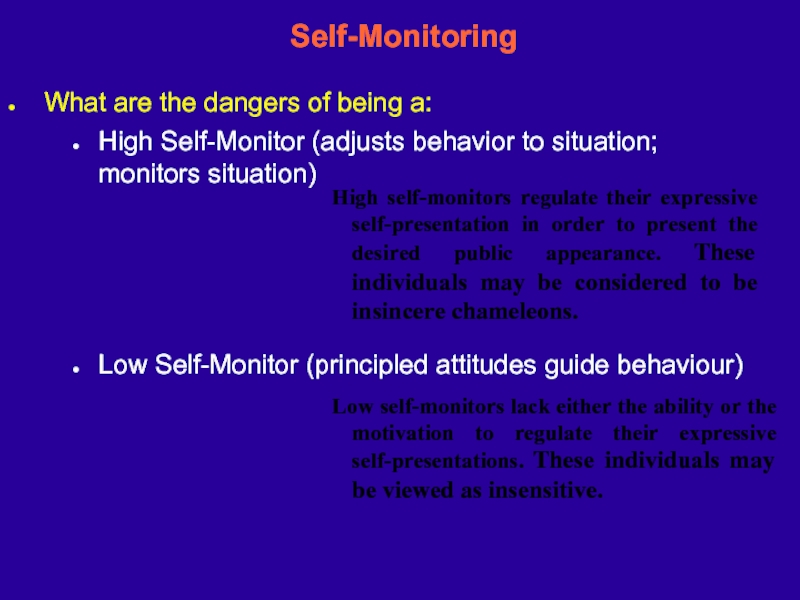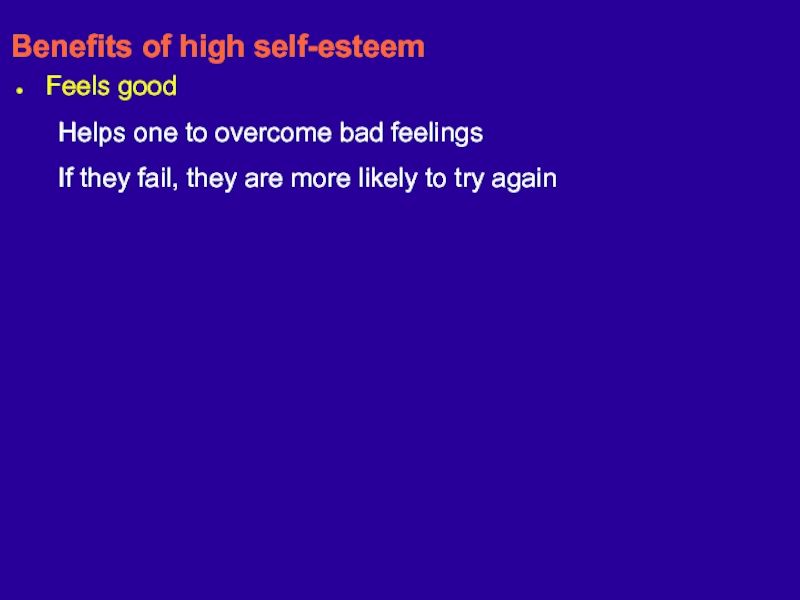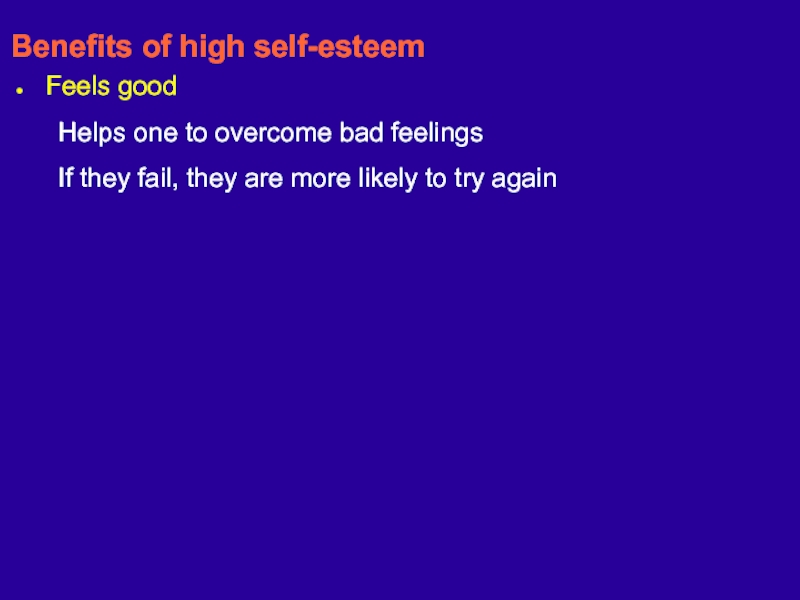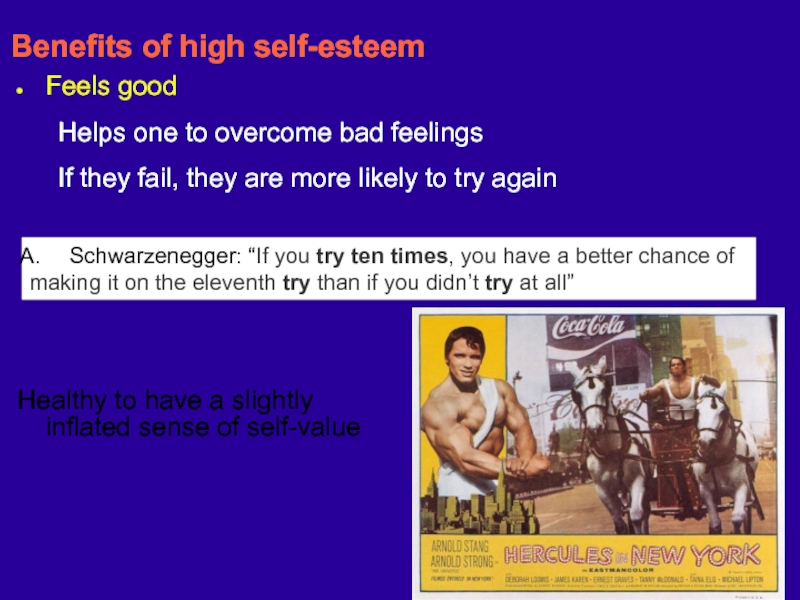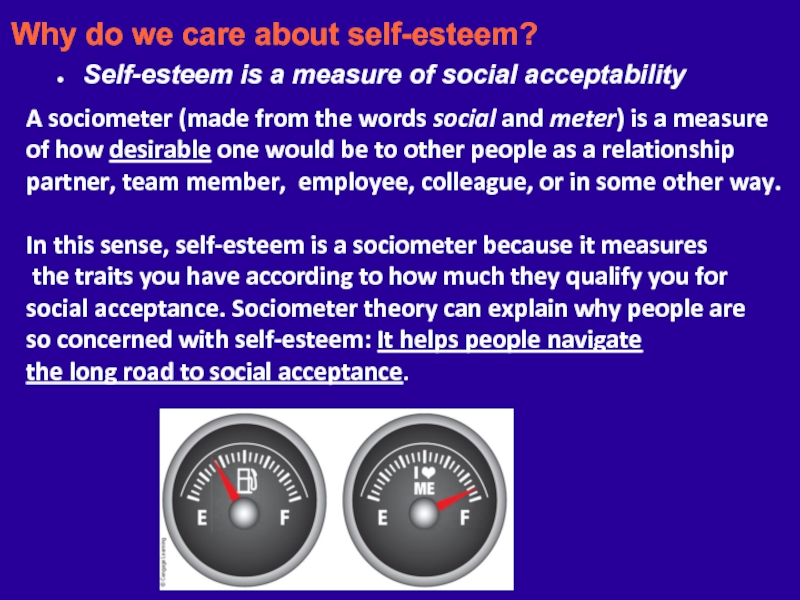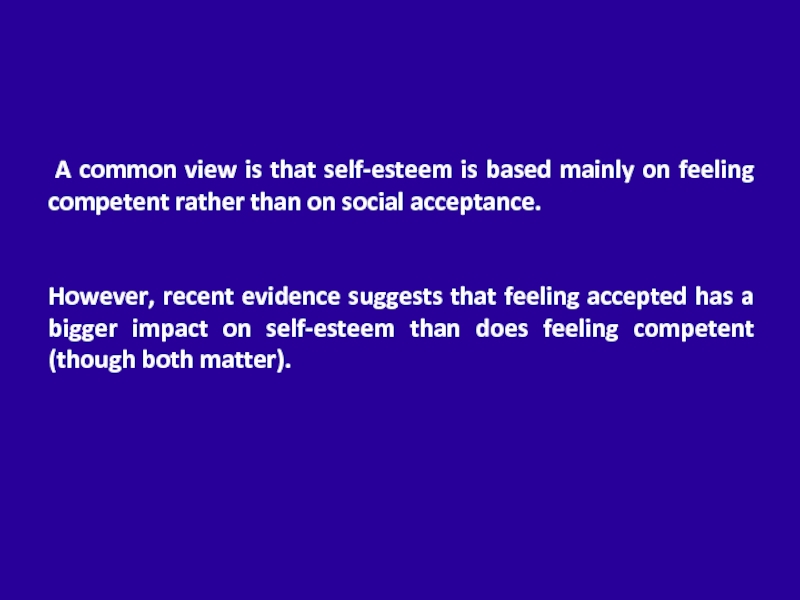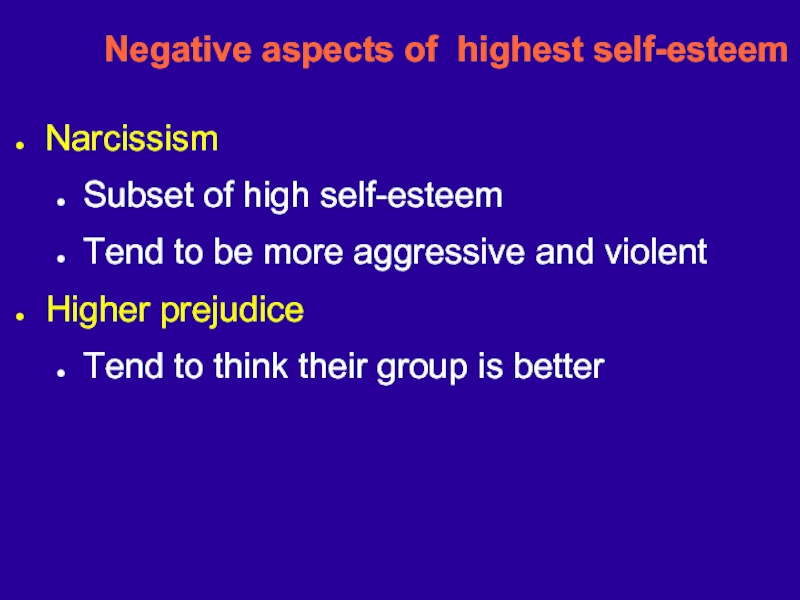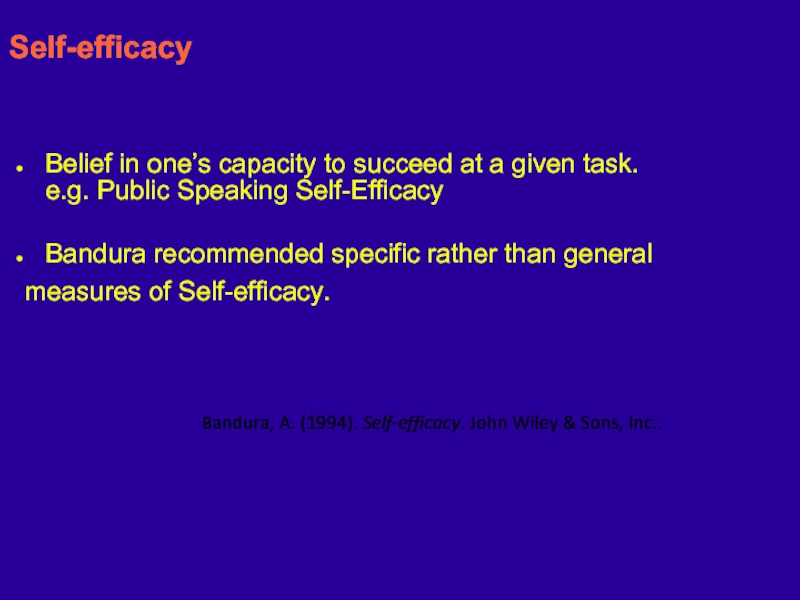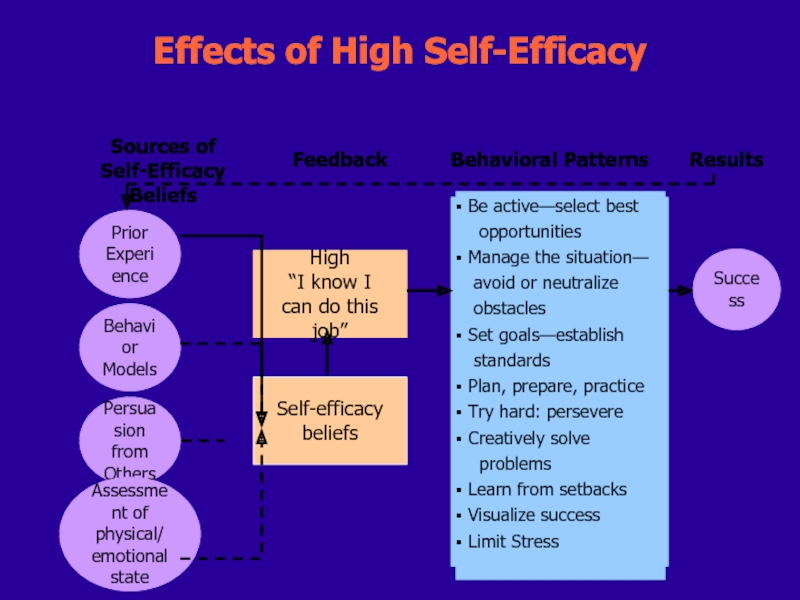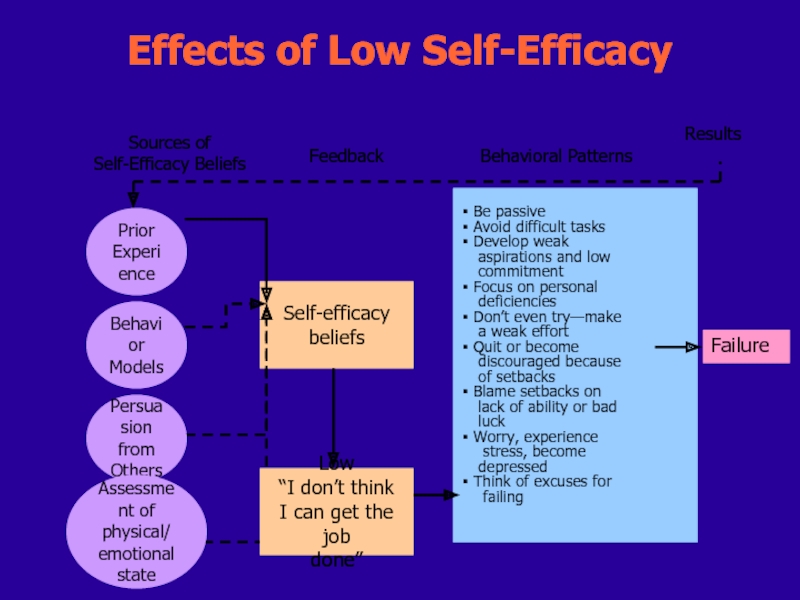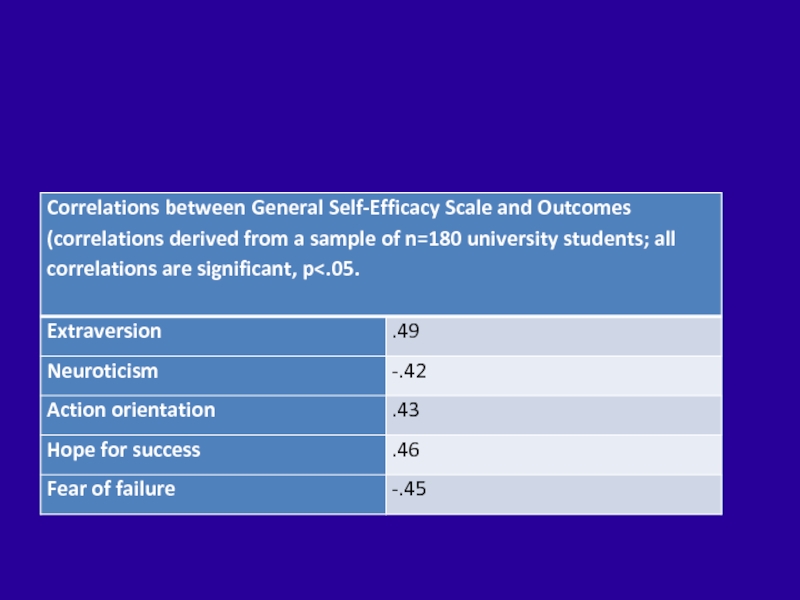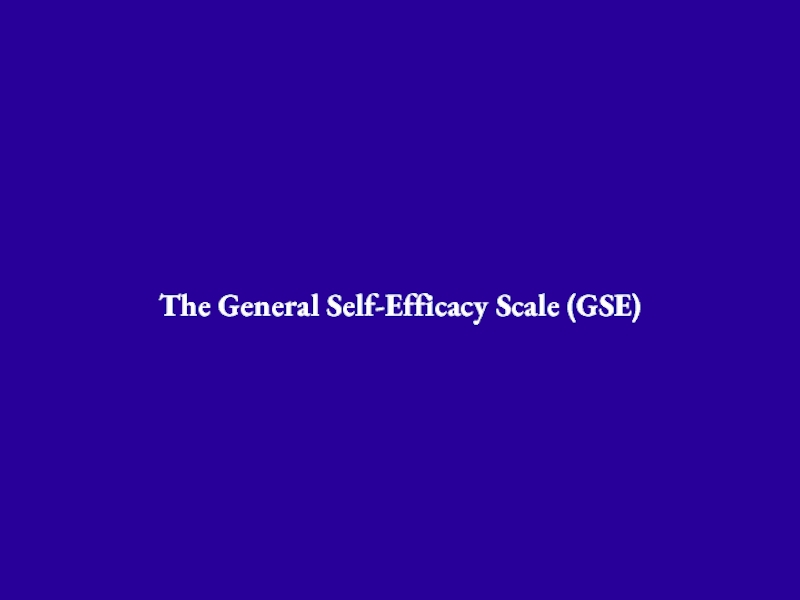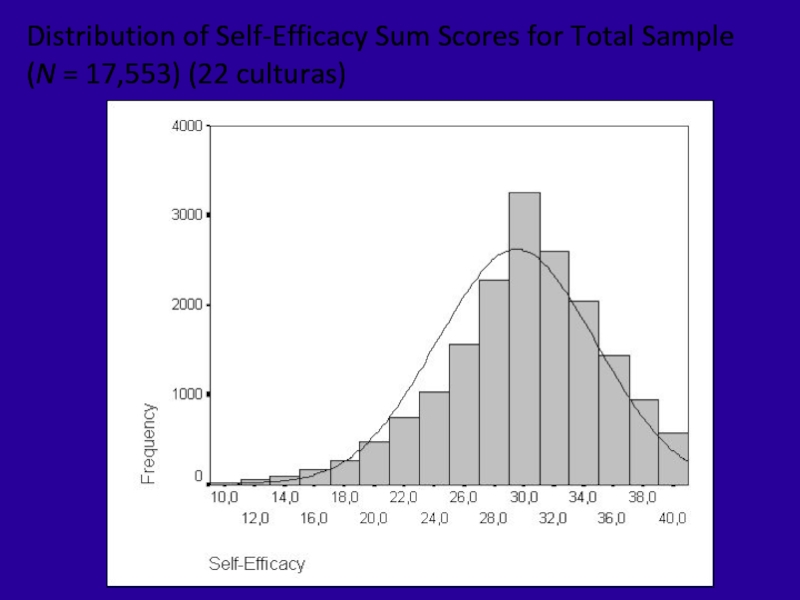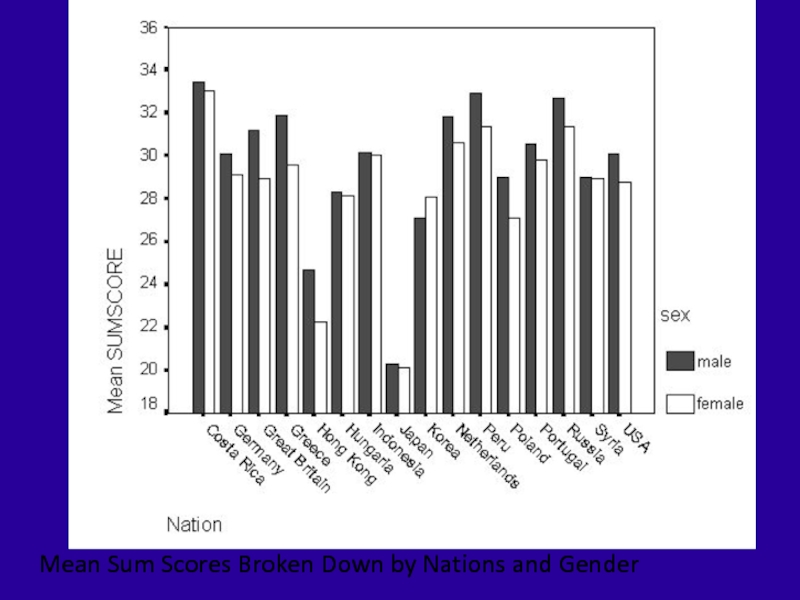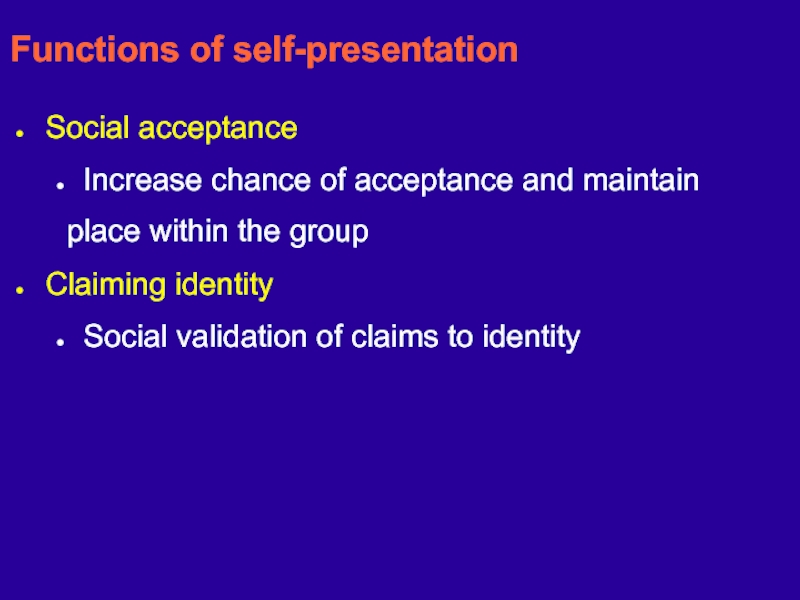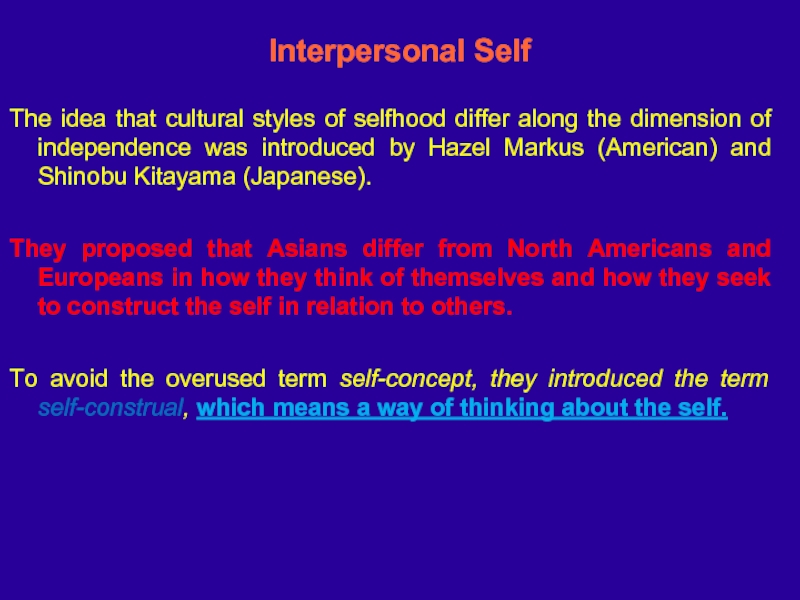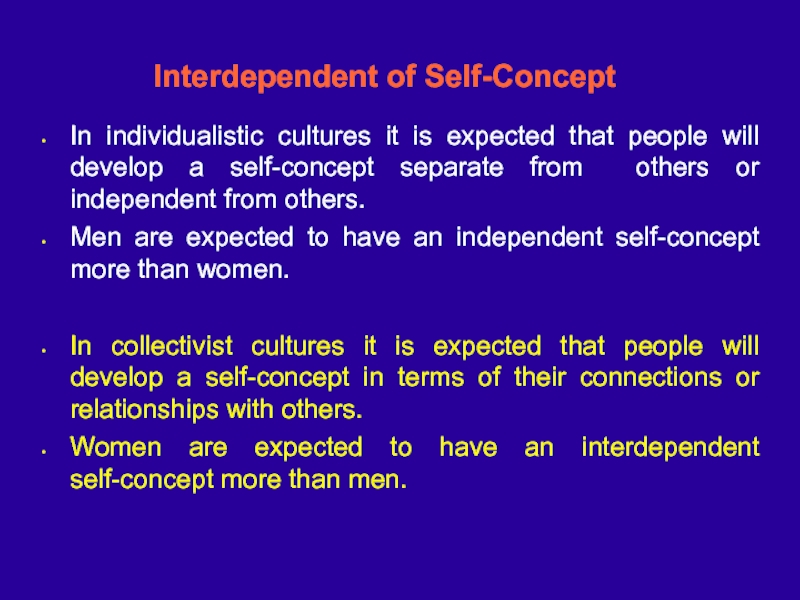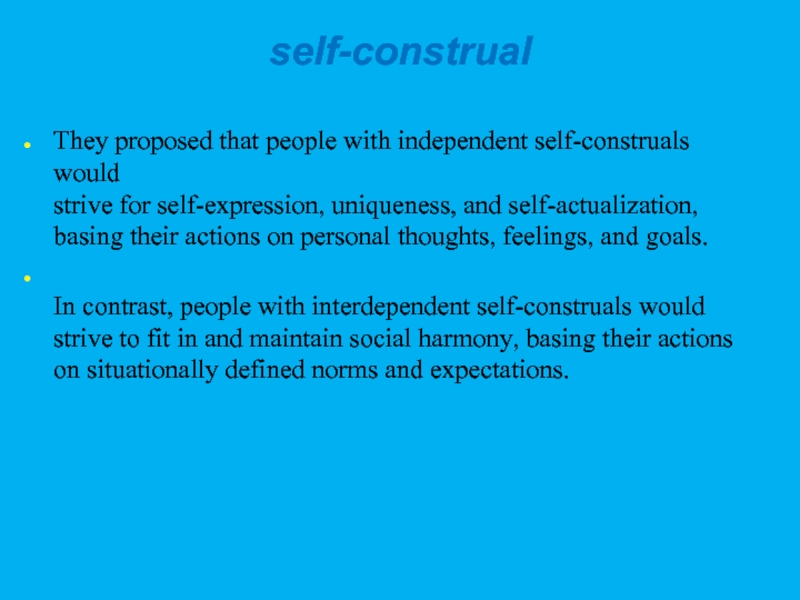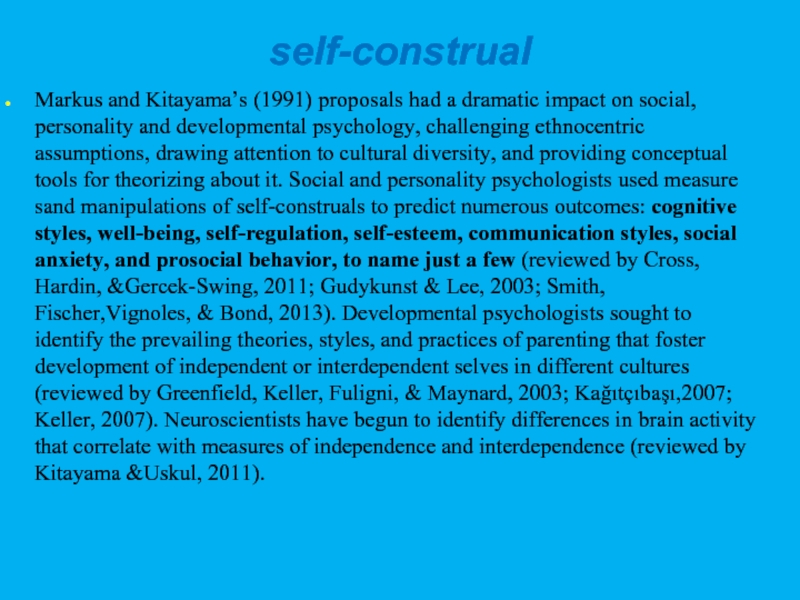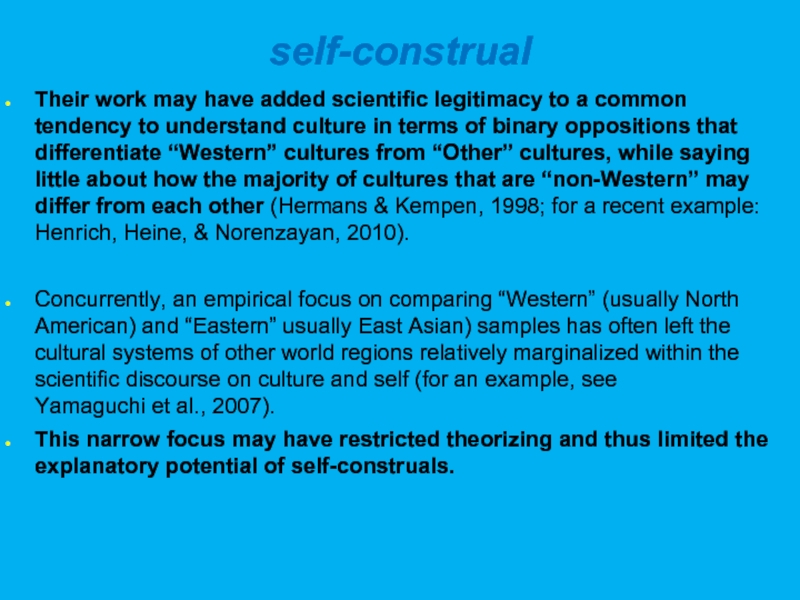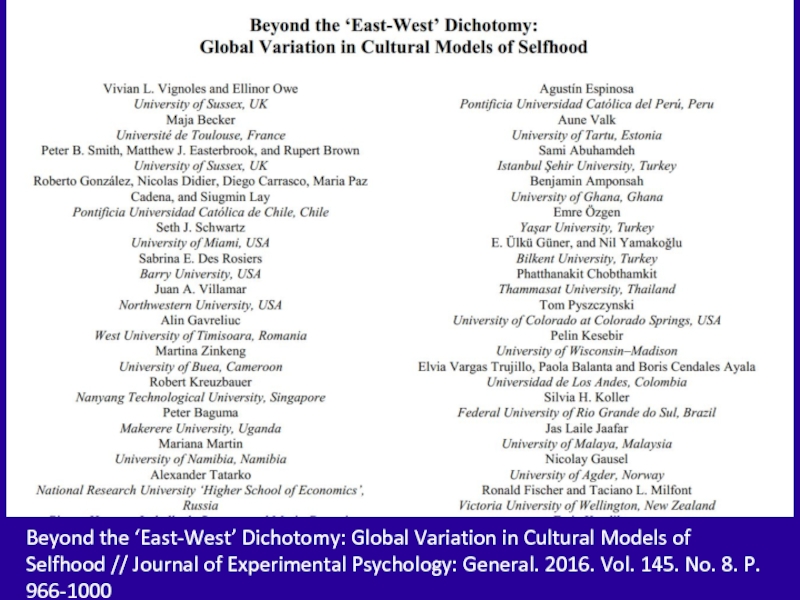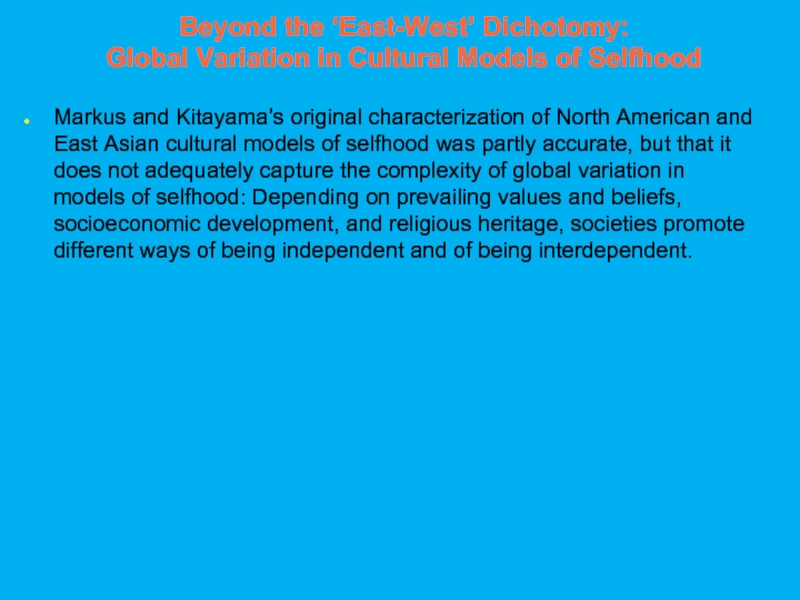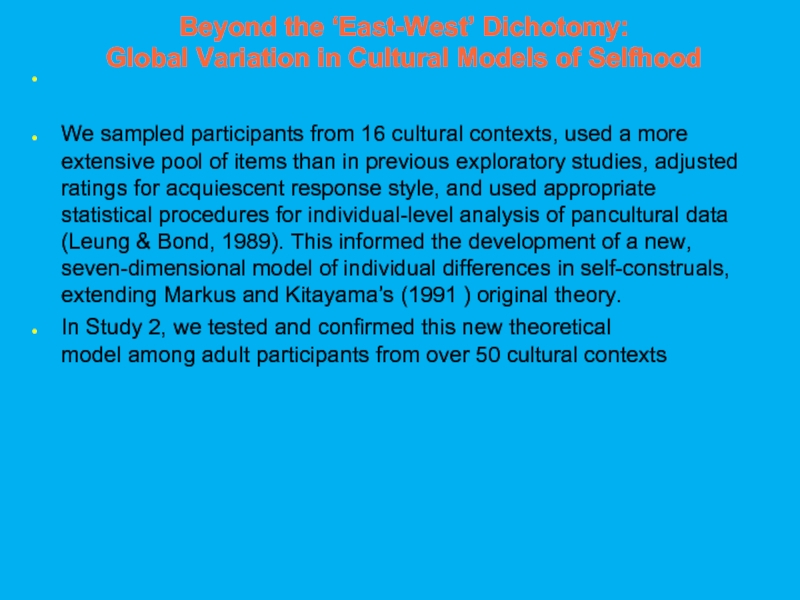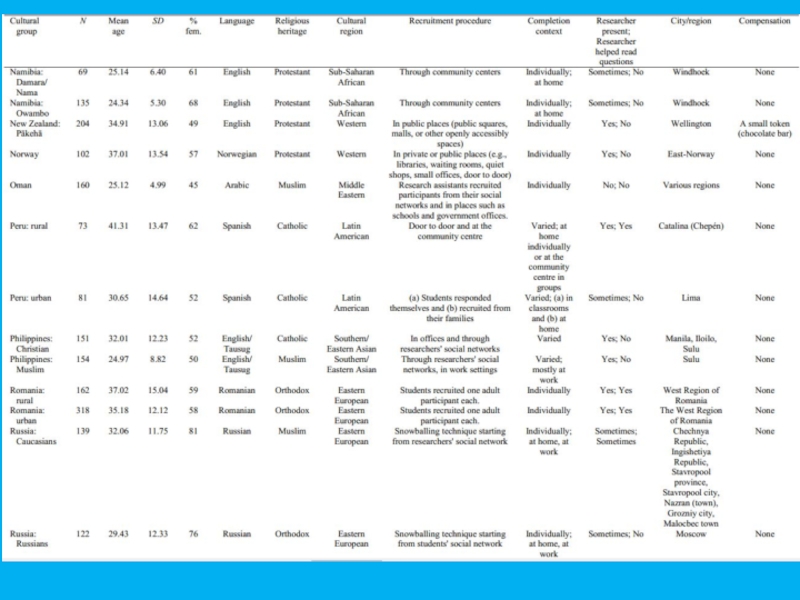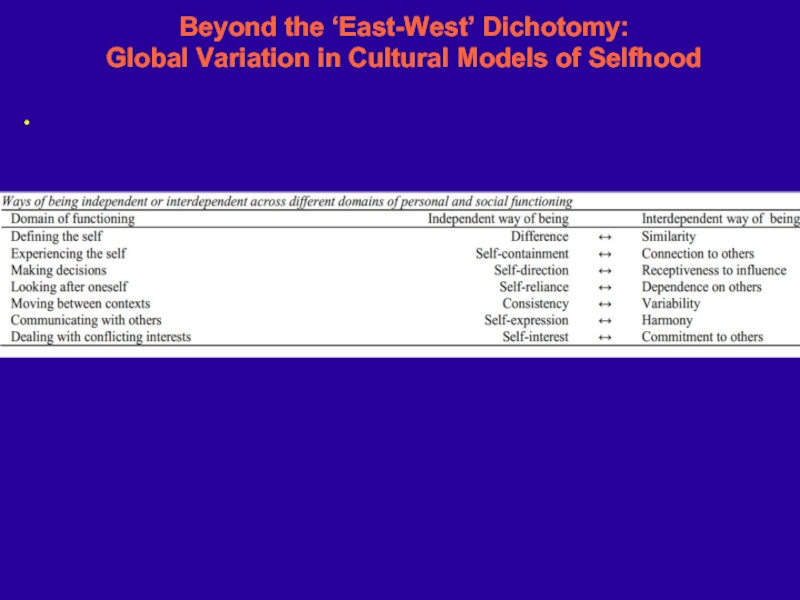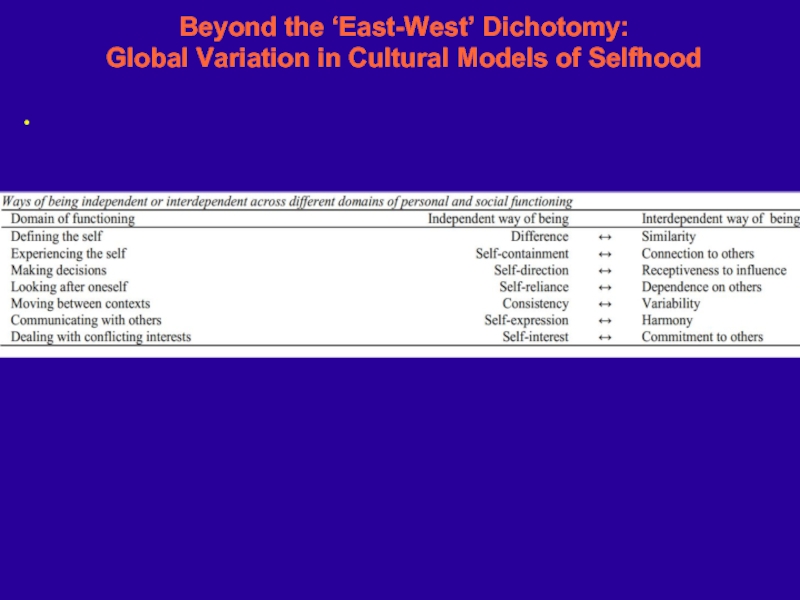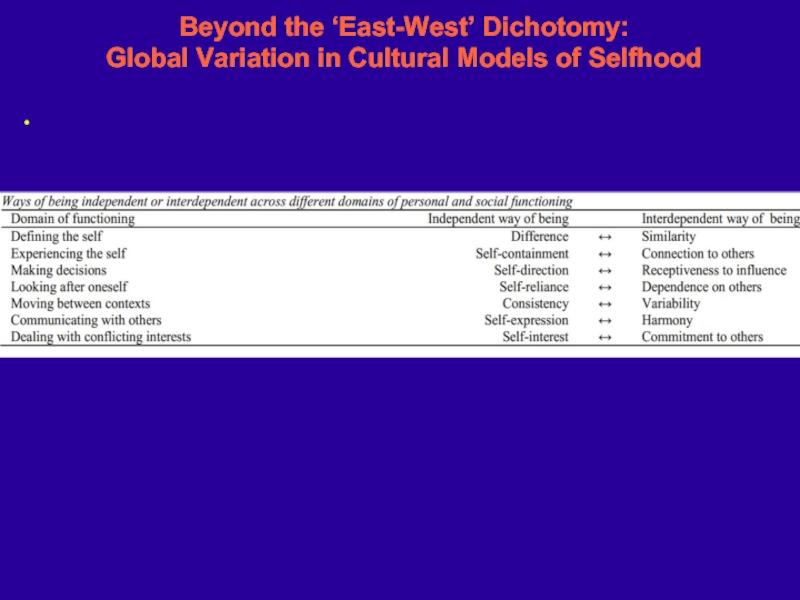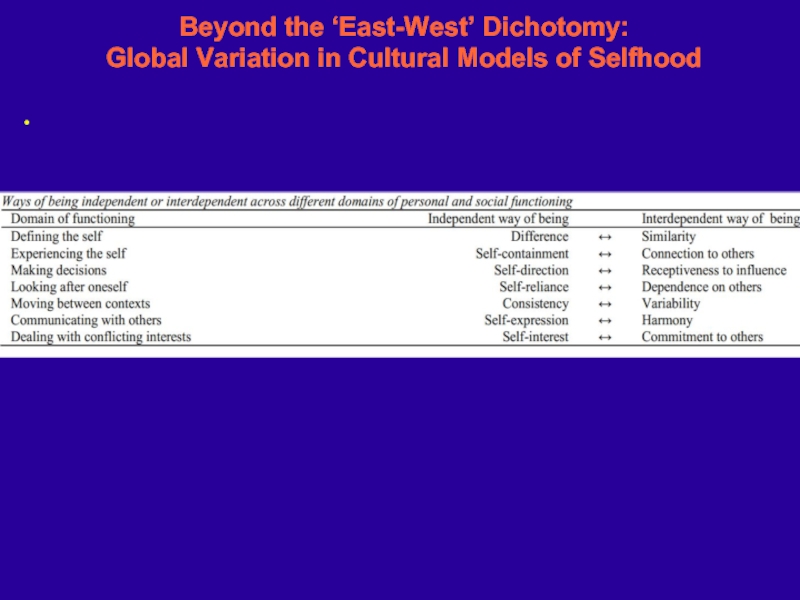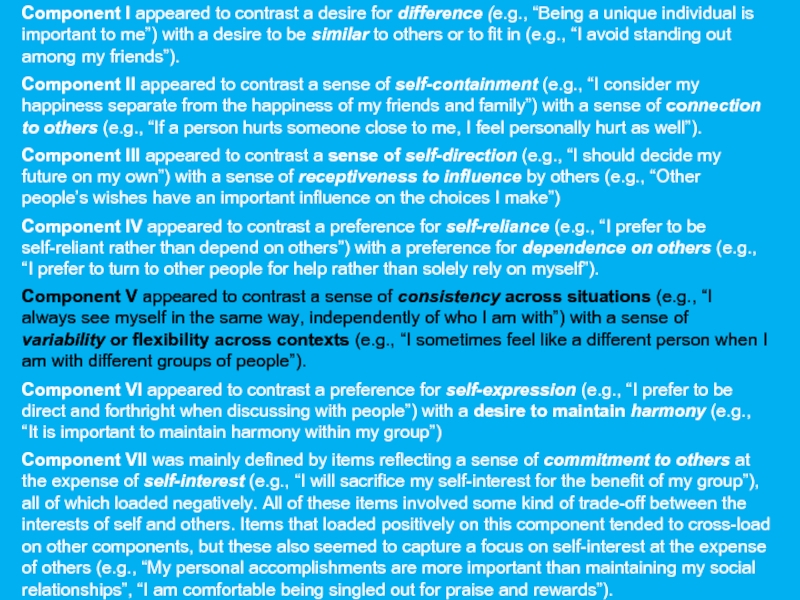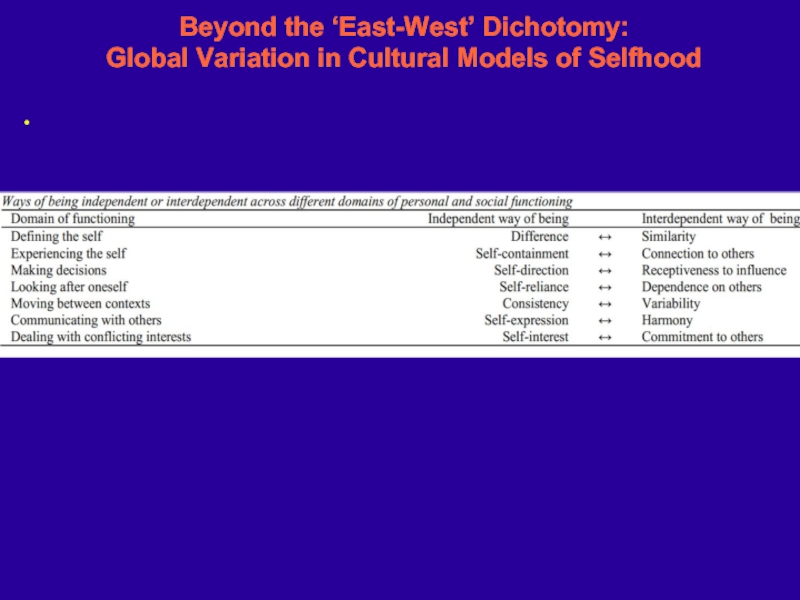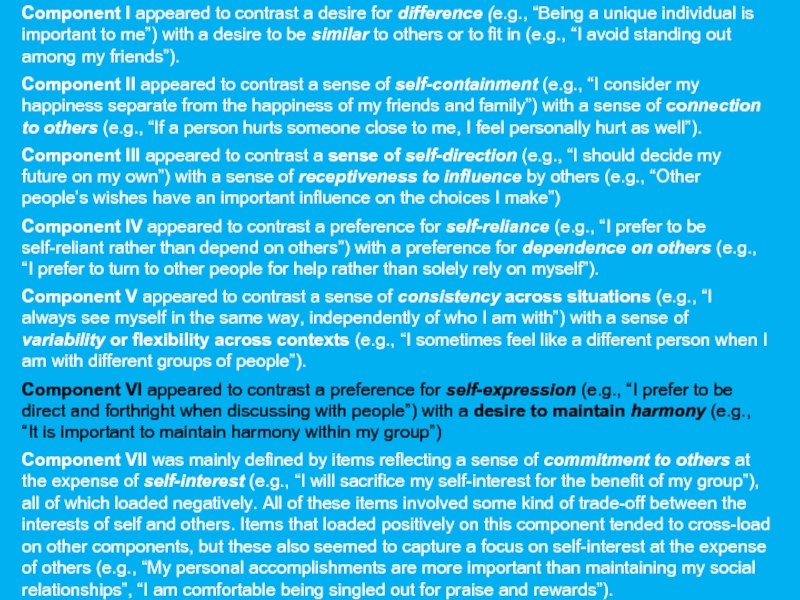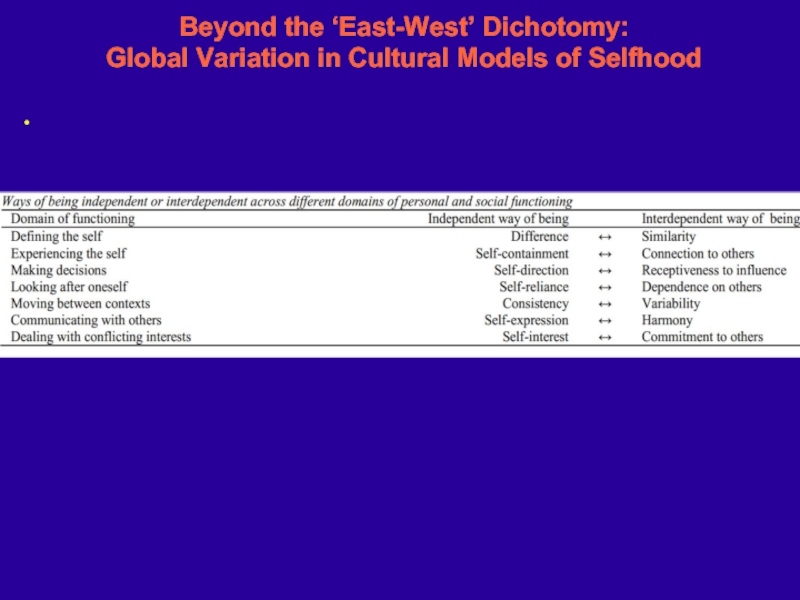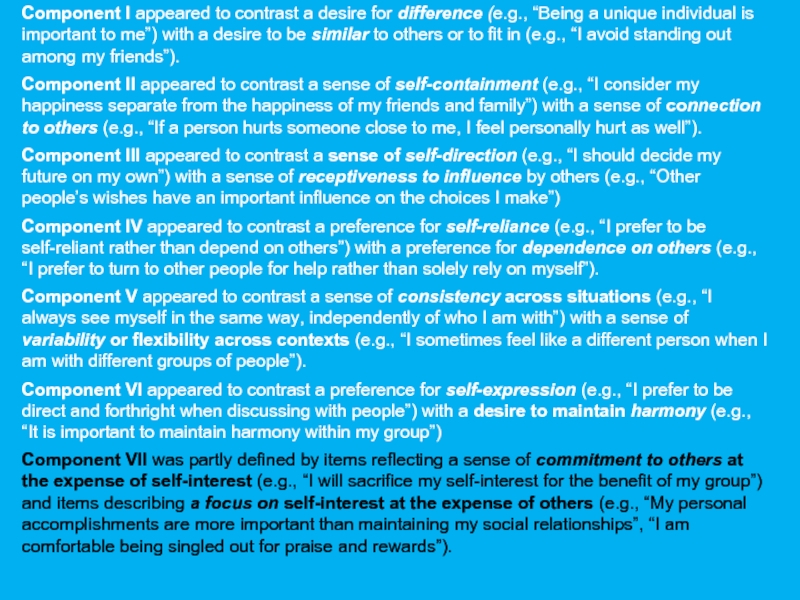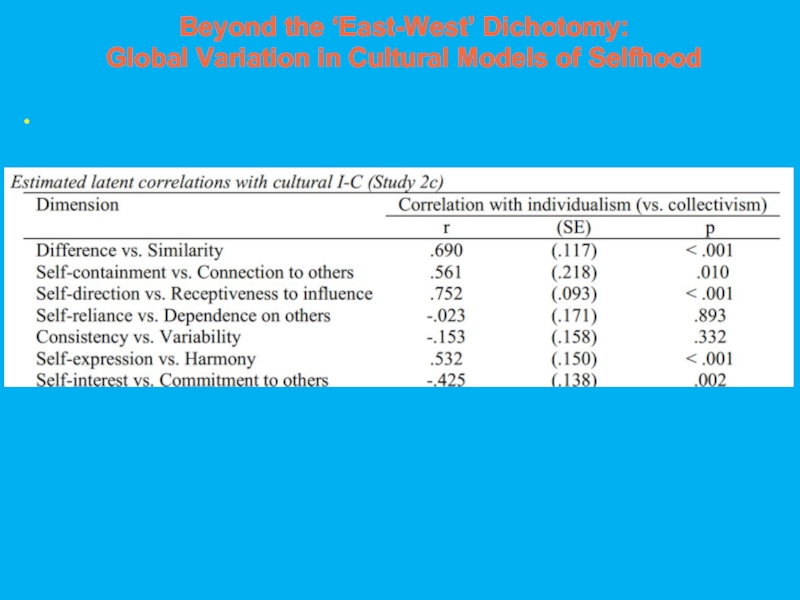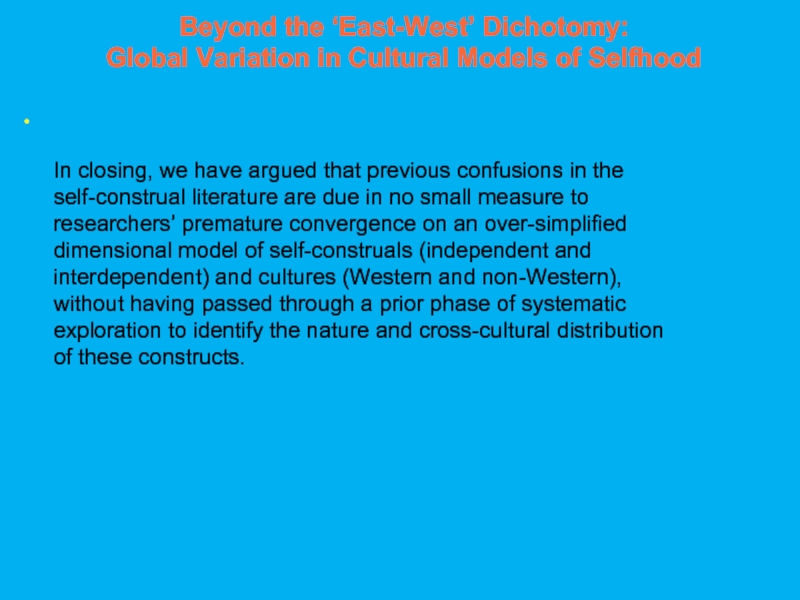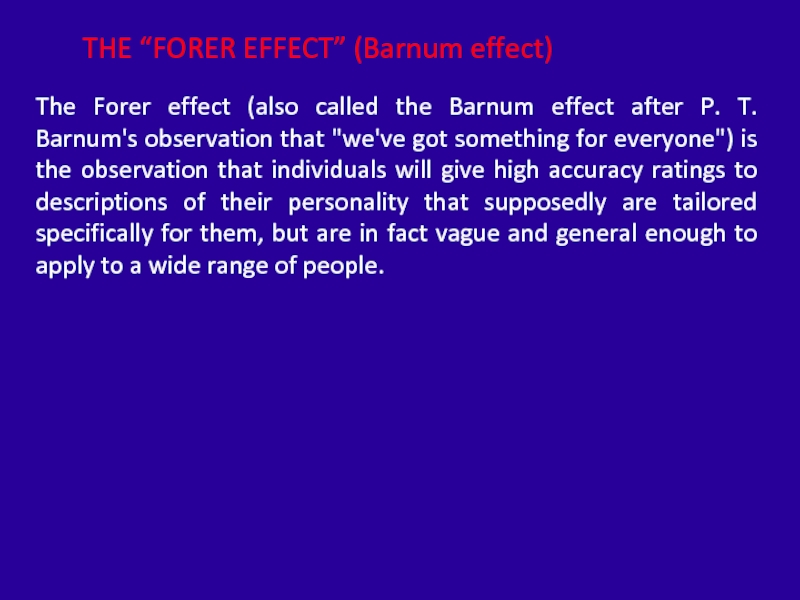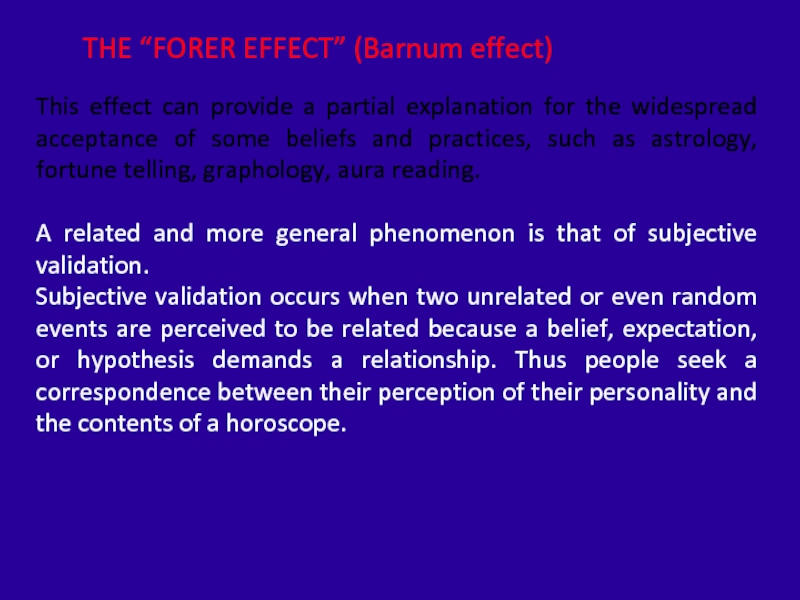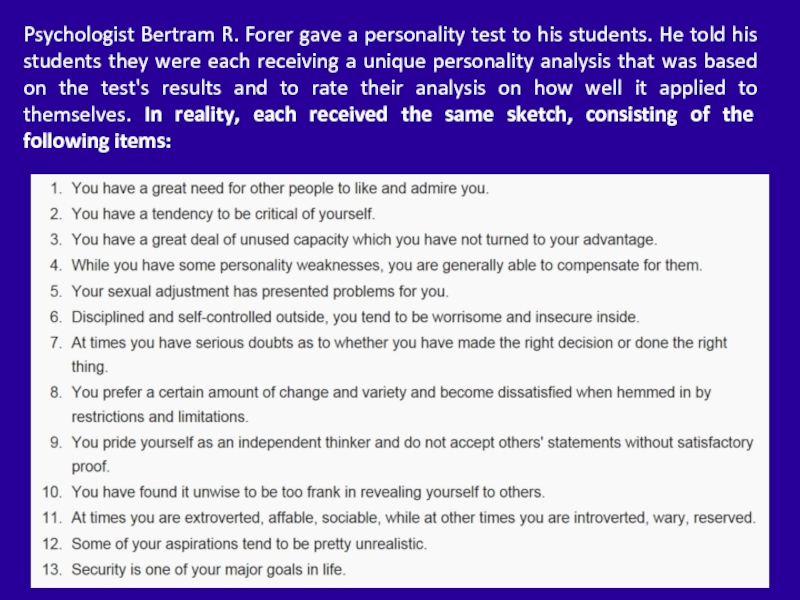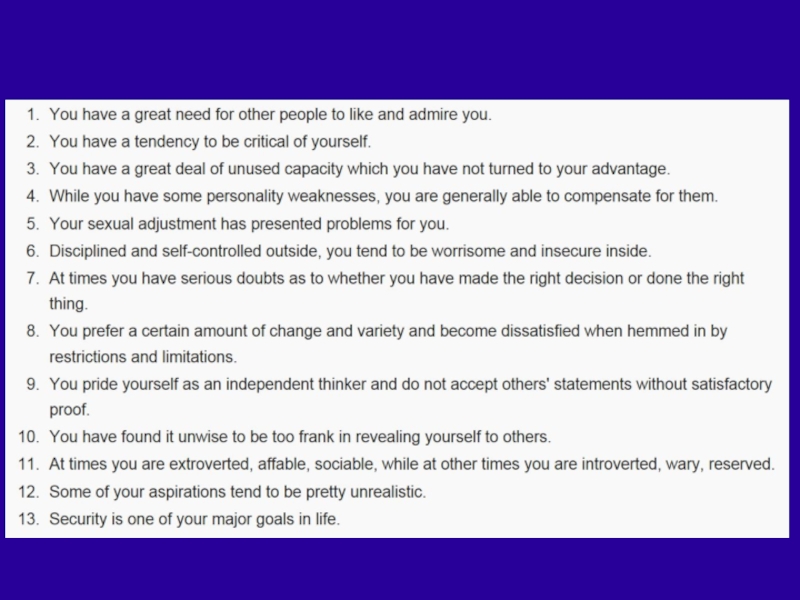- Главная
- Разное
- Дизайн
- Бизнес и предпринимательство
- Аналитика
- Образование
- Развлечения
- Красота и здоровье
- Финансы
- Государство
- Путешествия
- Спорт
- Недвижимость
- Армия
- Графика
- Культурология
- Еда и кулинария
- Лингвистика
- Английский язык
- Астрономия
- Алгебра
- Биология
- География
- Детские презентации
- Информатика
- История
- Литература
- Маркетинг
- Математика
- Медицина
- Менеджмент
- Музыка
- МХК
- Немецкий язык
- ОБЖ
- Обществознание
- Окружающий мир
- Педагогика
- Русский язык
- Технология
- Физика
- Философия
- Химия
- Шаблоны, картинки для презентаций
- Экология
- Экономика
- Юриспруденция
The social self презентация
Содержание
- 1. The social self
- 2. “NO TOPIC IS MORE INTERESTING TO PEOPLE
- 3. What is the “self”? In psychology: collection
- 4. What is the “self”? Most recently, “self”
- 5. Baumeister, Bushman, 2011 The self has
- 6. Self-concept Human beings have self-awareness, and this
- 7. Interpersonal self A second part of the
- 8. Agent Self The third important part of
- 9. Self-concept Self-awareness Self-esteem Self-deception Self-efficacy
- 10. Self-awareness Attention directed to the self
- 11. Self-awareness Early in the 1970s social
- 12. Self-reference Effect
- 13. Social Comparison Theory Festinger suggested that people
- 16. Social Comparison Theory Festinger suggested that people
- 19. self-affirmation theory People seek new
- 20. Self-Evaluation Maintenance Model In order to maintain
- 21. Self-deception strategies Self Serving Bias (mentioned in
- 22. Self-awareness Private self-awareness refers to attending
- 23. Self-Monitoring Self-monitoring is the degree to which
- 24. Self-Monitoring What are the dangers
- 25. Is high or low-self-monitoring related to job
- 26. Benefits of high self-esteem Feels good Helps
- 27. Self-esteem Self-esteem reflects a person's overall subjective
- 28. Benefits of high self-esteem Feels good Helps
- 29. Benefits of high self-esteem Feels good Helps
- 30. Self-esteem Self-esteem serves as a sociometer
- 31. Why do we care about self-esteem? Self-esteem
- 32. Why do we care about self-esteem? Self-esteem
- 33. A
- 34. Negative aspects of highest self-esteem Narcissism Subset
- 35. Self-efficacy Belief in one’s capacity to succeed
- 36. Effects of High Self-Efficacy Prior Experience
- 37. People can program themselves for success or
- 38. Effects of High Self-Efficacy Prior Experience
- 39. Effects of Low Self-Efficacy Sources of Self-Efficacy
- 41. The General Self-Efficacy Scale (GSE)
- 42. Distribution of Self-Efficacy Sum Scores for Total Sample (N = 17,553) (22 culturas)
- 43. Mean Sum Scores Broken Down by Nations and Gender
- 44. Interpersonal self self – presentation
- 45. Functions of self-presentation Social acceptance Increase chance
- 46. Interpersonal Self The idea that cultural styles
- 47. self-construal Markus and Kitayama (1991) published their
- 48. self-construal They argued that Western cultures are
- 49. Interdependent of Self-Concept In individualistic cultures it
- 50. self-construal They proposed that people with
- 52. self-construal Markus and Kitayama’s (1991) proposals had
- 53. self-construal Their work may have added scientific
- 54. Beyond the ‘East-West’ Dichotomy: Global Variation
- 55. Beyond the ‘East-West’ Dichotomy: Global Variation in
- 56. Beyond the ‘East-West’ Dichotomy: Global Variation in
- 57. Beyond the ‘East-West’ Dichotomy: Global Variation in
- 58. Beyond the ‘East-West’ Dichotomy: Global Variation in Cultural Models of Selfhood
- 59. Beyond the ‘East-West’ Dichotomy: Global Variation in Cultural Models of Selfhood
- 60. Component I appeared to contrast a desire
- 61. Beyond the ‘East-West’ Dichotomy: Global Variation in Cultural Models of Selfhood
- 62. Component I appeared to contrast a desire
- 63. Beyond the ‘East-West’ Dichotomy: Global Variation in Cultural Models of Selfhood
- 64. Component I appeared to contrast a desire
- 65. Beyond the ‘East-West’ Dichotomy: Global Variation in Cultural Models of Selfhood
- 66. Component I appeared to contrast a desire
- 67. Beyond the ‘East-West’ Dichotomy: Global Variation in Cultural Models of Selfhood
- 68. Component I appeared to contrast a desire
- 69. Beyond the ‘East-West’ Dichotomy: Global Variation in Cultural Models of Selfhood
- 70. Component I appeared to contrast a desire
- 71. Beyond the ‘East-West’ Dichotomy: Global Variation in Cultural Models of Selfhood
- 72. Component I appeared to contrast a desire
- 73. Beyond the ‘East-West’ Dichotomy: Global Variation in Cultural Models of Selfhood
- 74. Beyond the ‘East-West’ Dichotomy: Global Variation in Cultural Models of Selfhood
- 75. Beyond the ‘East-West’ Dichotomy: Global Variation in
- 76. Self-Interest
- 77. Self-interest THE “FORER EFFECT” (Barnum effect)
- 78. The Forer effect (also called the Barnum
- 79. This effect can provide a partial explanation
- 80. Psychologist Bertram R. Forer gave a personality
- 81. On average, the students rated its accuracy
- 82. THE “FORER EFFECT” (Barnum effect) Subjects give
- 84. This effect exists due to our self interest. Just someone who exploits our self interest.)
Слайд 2“NO TOPIC IS MORE
INTERESTING TO PEOPLE
THAN PEOPLE. FOR MOST
PEOPLE, MOREOVER, THE
MOST
THE SELF.”
—ROY F. BAUMEISTER,
THE SELF IN SOCIAL
PSYCHOLOGY, 1999
Слайд 3What is the “self”?
In psychology:
collection of cognitively-held beliefs that a person
about themselves.
However…
“Self” seems to extend beyond the physical self (body), to include psychologically meaningful personal possessions and personal space.
Many, varied theories about the purpose and function of the ‘self’ – e.g., philosophy, science, culture, religion.
Слайд 4What is the “self”?
Most recently, “self” has been further complexified and
increasingly seen as:
Dynamic & changeable
Multiple / Plural
Hierarchical
Situational & cognitively influenced
Culturally constructed
Interest in the self increased rapidly in the 1960s and 1970s.
Слайд 5 Baumeister, Bushman, 2011
The self has three main parts, which correspond
Слайд 6Self-concept
Human beings have self-awareness, and this awareness enables them to develop
If someone says “Tell me something about yourself,” you can probably furnish 15 or 20 specific answers without having to think very hard.
You check your hair in a mirror or your weight on a scale. You read your horoscope or the results of some medical tests.
Such moments show the self reflecting on itself and on its store of information about itself.
.
Слайд 7Interpersonal self
A second part of the self that helps the person
Most people have a certain image that they try to convey to others. This public self bears some resemblance to the self-concept, but the two are not the same. Often, people work hard to present a particular image others even if it is not exactly the full, precise truth as they know it.
Furthermore, many emotions indicate concern over how one appears to others: You feel embarrassed because someone saw you do something stupid, or even just because your underwear was showing.
You feel guilty if you forgot your romantic partner’s birthday. You are delighted when your boss compliments you on your good work. These episodes reveal that the self is often working in complex ways to gain social acceptance and maintain good interpersonal relationships.
.
.
Слайд 8Agent Self
The third important part of the self, the agent self,
Sometimes you decide not to eat something because it is unhealthy or fattening.
Sometimes you make a promise and later exert yourself to keep it. Sometimes you decide what courses to take or what job to take. Perhaps you cast a vote in an election. Perhaps you sign a lease for an apartment. Perhaps you place a bet on a sports event.
All these actions reveal the self as not just a knower but also as a doer. .
Слайд 10Self-awareness
Attention directed to the self
Usually involves evaluative comparison.
In general, people
about themselves (but a lot of time is spent thinking
about self-presentation and self-preservation)
Certain situations
(e.g., mirrors, cameras, audiences, self-development exercises)
Слайд 11Self-awareness
Early in the 1970s social psychologists began studying the difference
They developed several clever procedures to increase self-awareness, such as having people work while seated in front of a mirror, or telling people that they were being videotaped.
Слайд 12 Self-reference Effect
Information bearing on self is
Слайд 13Social Comparison Theory
Festinger suggested that people compare themselves to others because,
Слайд 16Social Comparison Theory
Festinger suggested that people compare themselves to others because,
- Desire to see self-positively appears more powerful that desire to see self-accurately
In-group comparisons “my salary is pretty good for a woman.”
Suls, J. E., & Wills, T. A. E. (1991). Social comparison: Contemporary theory and research. Lawrence Erlbaum Associates, Inc.
Слайд 19
self-affirmation theory
People seek new favourable knowledge about themselves as well as
People are guided by a self-enhancement motive (e.g. Kunda, 1990).
One manifestation of this motive is described by self-affirmation theory (Sherman & Cohen, 2006).
People strive publicly to affirm positive aspects of who they are.
The urge to self-affirm is particularly strong when an aspect of one's self-esteem has been damaged.
So, for example, if someone draws attention to the fact that you are a lousy artist, you might retort that while that might be true, you are an excellent dancer.
Слайд 20Self-Evaluation Maintenance Model
In order to maintain a positive view of the
Tesser, A. (1988). Toward a self-evaluation maintenance model of social behavior. Advances in experimental social psychology, 21, 181-227.
Слайд 21Self-deception strategies
Self Serving Bias (mentioned in the previous lecture)
More skeptical of
Comparisons to those slightly worse
Skew impressions of others to highlight
own good traits as unusual
Слайд 22Self-awareness
Private self-awareness
refers to attending to your inner states, including emotions,
Рublic self-awareness
means attending to how you are perceived by others, including
what others might think of you.
Слайд 23Self-Monitoring
Self-monitoring is the degree to which you are aware of how
Observing one’s own behavior and adapting it to the situation
Слайд 24 Self-Monitoring
What are the dangers of being a:
High Self-Monitor (adjusts behavior
Low Self-Monitor (principled attitudes guide behaviour)
High self-monitors regulate their expressive self-presentation in order to present the desired public appearance. These individuals may be considered to be insincere chameleons.
Low self-monitors lack either the ability or the motivation to regulate their expressive self-presentations. These individuals may be viewed as insensitive.
Слайд 25Is high or low-self-monitoring related to job success?
Research (meta-analysis) has shown
Слайд 26Benefits of high self-esteem
Feels good
Helps one to overcome bad feelings
If
Слайд 27Self-esteem
Self-esteem reflects a person's overall subjective emotional evaluation of his or
"The self-concept is what we think about the self; self-esteem, is the positive or negative evaluations of the self, as in how we feel about it” (Smith, E. R.; Mackie, D. M. (2007). Social Psychology (Third ed.). Hove: Psychology Press)
Слайд 28Benefits of high self-esteem
Feels good
Helps one to overcome bad feelings
If
Слайд 29Benefits of high self-esteem
Feels good
Helps one to overcome bad feelings
If
Schwarzenegger: “If you try ten times, you have a better chance of
making it on the eleventh try than if you didn’t try at all”
Healthy to have a slightly inflated sense of self-value
Слайд 30Self-esteem
Self-esteem serves as a sociometer for one’s standing
in a group.
Sociometer
This theoretical perspective was first introduced by
Mark Leary and colleagues in 1995 and later expanded
on by Kirkpatrick and Ellis (2001).
Слайд 31Why do we care about self-esteem?
Self-esteem is a measure of social
A sociometer (made from the words social and meter) is a measure
of how desirable one would be to other people as a relationship
partner, team member, employee, colleague, or in some other way.
In this sense, self-esteem is a sociometer because it measures
the traits you have according to how much they qualify you for
social acceptance. Sociometer theory can explain why people are
so concerned with self-esteem: It helps people navigate
the long road to social acceptance.
Слайд 32Why do we care about self-esteem?
Self-esteem is a measure of social
Mark Leary, the author of sociometer theory, compares self-esteem to the gas gauge on a car. A gas gauge may seem trivial because it doesn’t make the car go forward. But the gas gauge tells you about something that is important—namely, whether there is enough
fuel in the car.
Just as drivers act out of concern to keep their gas gauge above zero, so people seem constantly to act so as to preserve their self-esteem.
Слайд 33
A common view is that self-esteem is based mainly on
However, recent evidence suggests that feeling accepted has a bigger impact on self-esteem than does feeling competent (though both matter).
Слайд 34Negative aspects of highest self-esteem
Narcissism
Subset of high self-esteem
Tend to be more
Higher prejudice
Tend to think their group is better
Слайд 35Self-efficacy
Belief in one’s capacity to succeed at a given task.
e.g. Public
Bandura recommended specific rather than general
measures of Self-efficacy.
Bandura, A. (1994). Self‐efficacy. John Wiley & Sons, Inc..
Слайд 36Effects of High Self-Efficacy
Prior
Experience
Sources of Self-Efficacy Beliefs
Feedback
Behavioral Patterns
Results
High
“I know
can do this job”
Self-efficacy
beliefs
Success
Behavior
Models
Persuasion
from Others
Assessment of
physical/
emotional
state
Слайд 37People can program themselves for success or failure by enacting their
Let’s use a work-related example. Let’s say your company has asked you to take on an international assignment for two years. Let’s analyze the sources of your self-efficacy in accomplishing that assignment successfully.
Prior experience – have you done this before and been successful? This is the most important driver of your self-efficacy. What past experiences would be relevant in our example? Prior assignments, traveling abroad, having good experiences, knowledge of the language.
Behavior models – success or failure of others who have done this. Have coworkers you know enjoyed their experiences and been successful?
Persuasion from others – what kind of support does your organization provide, for example, will they help your spouse get a job, will they help you plan your re-entry back into the country? Do they present it as you are really the right person for the job or do you more have the feeling that they just needed someone to go.
Assessment of physical or emotional states – would you miss home and everything that is familiar to you? Maybe you have a health condition that you feel may prohibit your ability to perform well.
Слайд 38Effects of High Self-Efficacy
Prior
Experience
Sources of Self-Efficacy Beliefs
Feedback
Behavioral Patterns
Results
High
“I know
can do this job”
Self-efficacy
beliefs
Success
Behavior
Models
Persuasion
from Others
Assessment of
physical/
emotional
state
Слайд 39Effects of Low Self-Efficacy
Sources of Self-Efficacy Beliefs
Feedback
Behavioral Patterns
Results
Self-efficacy
beliefs
Low
“I don’t think
I can
done”
Failure
Prior
Experience
Behavior
Models
Persuasion
from Others
Assessment of
physical/
emotional
state
Слайд 44Interpersonal self
self – presentation
Behaviors that convey an image to others
Public esteem
More
Слайд 45Functions of self-presentation
Social acceptance
Increase chance of acceptance and maintain
place within
Claiming identity
Social validation of claims to identity
Слайд 46Interpersonal Self
The idea that cultural styles of selfhood differ along the
They proposed that Asians differ from North Americans and Europeans in how they think of themselves and how they seek to construct the self in relation to others.
To avoid the overused term self-concept, they introduced the term self-construal, which means a way of thinking about the self.
Слайд 47self-construal
Markus and Kitayama (1991) published their classic article on culture and
Слайд 48self-construal
They argued that Western cultures are unusual in promoting an independent
Слайд 49Interdependent of Self-Concept
In individualistic cultures it is expected that people will
Men are expected to have an independent self-concept more than women.
In collectivist cultures it is expected that people will develop a self-concept in terms of their connections or relationships with others.
Women are expected to have an interdependent self-concept more than men.
Слайд 50self-construal
They proposed that people with independent self-construals would
strive for self-expression, uniqueness,
In contrast, people with interdependent self-construals would strive to fit in and maintain social harmony, basing their actions on situationally defined norms and expectations.
Слайд 52self-construal
Markus and Kitayama’s (1991) proposals had a dramatic impact on social,
Слайд 53self-construal
Their work may have added scientific legitimacy to a common tendency
Concurrently, an empirical focus on comparing “Western” (usually North American) and “Eastern” usually East Asian) samples has often left the cultural systems of other world regions relatively marginalized within the scientific discourse on culture and self (for an example, see Yamaguchi et al., 2007).
This narrow focus may have restricted theorizing and thus limited the explanatory potential of self-construals.
Слайд 54
Beyond the ‘East-West’ Dichotomy: Global Variation in Cultural Models of Selfhood
Слайд 55Beyond the ‘East-West’ Dichotomy:
Global Variation in Cultural Models of Selfhood
Markus and
Слайд 56Beyond the ‘East-West’ Dichotomy:
Global Variation in Cultural Models of Selfhood
We sampled
In Study 2, we tested and confirmed this new theoretical model among adult participants from over 50 cultural contexts
Слайд 57Beyond the ‘East-West’ Dichotomy:
Global Variation in Cultural Models of Selfhood
We tested
Rather than equating ‘culture’ with ‘nation’, we targeted several cultural groups within each nation where relevant and feasible. The nature of the groups varied from nation to nation, such that the differences might be regional (e.g., Eastern and Western Germany), religious (e.g., Baptists and Orthodox Christians in Georgia) or ethnic (e.g., Damara and Owambo in Namibia). We collected data from over 7,000 adult members of 55 cultural groups in 33 nations, spanning all inhabited continents.
Слайд 60Component I appeared to contrast a desire for difference (e.g., “Being
Component II appeared to contrast a sense of self-containment (e.g., “I consider my happiness separate from the happiness of my friends and family”) with a sense of connection to others (e.g., “If a person hurts someone close to me, I feel personally hurt as well”).
Component III appeared to contrast a sense of self-direction (e.g., “I should decide my future on my own”) with a sense of receptiveness to influence by others (e.g., “Other people’s wishes have an important influence on the choices I make”)
Component IV appeared to contrast a preference for self-reliance (e.g., “I prefer to be self-reliant rather than depend on others”) with a preference for dependence on others (e.g., “I prefer to turn to other people for help rather than solely rely on myself”).
Component V appeared to contrast a sense of consistency across situations (e.g., “I always see myself in the same way, independently of who I am with”) with a sense of variability or flexibility across contexts (e.g., “I sometimes feel like a different person when I am with different groups of people”).
Component VI appeared to contrast a preference for self-expression (e.g., “I prefer to be direct and forthright when discussing with people”) with a desire to maintain harmony (e.g., “It is important to maintain harmony within my group”)
Component VII was mainly defined by items reflecting a sense of commitment to others at the expense of self-interest (e.g., “I will sacrifice my self-interest for the benefit of my group”), all of which loaded negatively. All of these items involved some kind of trade-off between the interests of self and others. Items that loaded positively on this component tended to cross-load on other components, but these also seemed to capture a focus on self-interest at the expense of others (e.g., “My personal accomplishments are more important than maintaining my social relationships”, “I am comfortable being singled out for praise and rewards”).
Слайд 62Component I appeared to contrast a desire for difference (e.g., “Being
Component II appeared to contrast a sense of self-containment (e.g., “I consider my happiness separate from the happiness of my friends and family”) with a sense of connection to others (e.g., “If a person hurts someone close to me, I feel personally hurt as well”).
Component III appeared to contrast a sense of self-direction (e.g., “I should decide my future on my own”) with a sense of receptiveness to influence by others (e.g., “Other people’s wishes have an important influence on the choices I make”)
Component IV appeared to contrast a preference for self-reliance (e.g., “I prefer to be self-reliant rather than depend on others”) with a preference for dependence on others (e.g., “I prefer to turn to other people for help rather than solely rely on myself”).
Component V appeared to contrast a sense of consistency across situations (e.g., “I always see myself in the same way, independently of who I am with”) with a sense of variability or flexibility across contexts (e.g., “I sometimes feel like a different person when I am with different groups of people”).
Component VI appeared to contrast a preference for self-expression (e.g., “I prefer to be direct and forthright when discussing with people”) with a desire to maintain harmony (e.g., “It is important to maintain harmony within my group”)
Component VII was mainly defined by items reflecting a sense of commitment to others at the expense of self-interest (e.g., “I will sacrifice my self-interest for the benefit of my group”), all of which loaded negatively. All of these items involved some kind of trade-off between the interests of self and others. Items that loaded positively on this component tended to cross-load on other components, but these also seemed to capture a focus on self-interest at the expense of others (e.g., “My personal accomplishments are more important than maintaining my social relationships”, “I am comfortable being singled out for praise and rewards”).
Слайд 64Component I appeared to contrast a desire for difference (e.g., “Being
Component II appeared to contrast a sense of self-containment (e.g., “I consider my happiness separate from the happiness of my friends and family”) with a sense of connection to others (e.g., “If a person hurts someone close to me, I feel personally hurt as well”).
Component III appeared to contrast a sense of self-direction (e.g., “I should decide my future on my own”) with a sense of receptiveness to influence by others (e.g., “Other people’s wishes have an important influence on the choices I make”)
Component IV appeared to contrast a preference for self-reliance (e.g., “I prefer to be self-reliant rather than depend on others”) with a preference for dependence on others (e.g., “I prefer to turn to other people for help rather than solely rely on myself”).
Component V appeared to contrast a sense of consistency across situations (e.g., “I always see myself in the same way, independently of who I am with”) with a sense of variability or flexibility across contexts (e.g., “I sometimes feel like a different person when I am with different groups of people”).
Component VI appeared to contrast a preference for self-expression (e.g., “I prefer to be direct and forthright when discussing with people”) with a desire to maintain harmony (e.g., “It is important to maintain harmony within my group”)
Component VII was mainly defined by items reflecting a sense of commitment to others at the expense of self-interest (e.g., “I will sacrifice my self-interest for the benefit of my group”), all of which loaded negatively. All of these items involved some kind of trade-off between the interests of self and others. Items that loaded positively on this component tended to cross-load on other components, but these also seemed to capture a focus on self-interest at the expense of others (e.g., “My personal accomplishments are more important than maintaining my social relationships”, “I am comfortable being singled out for praise and rewards”).
Слайд 66Component I appeared to contrast a desire for difference (e.g., “Being
Component II appeared to contrast a sense of self-containment (e.g., “I consider my happiness separate from the happiness of my friends and family”) with a sense of connection to others (e.g., “If a person hurts someone close to me, I feel personally hurt as well”).
Component III appeared to contrast a sense of self-direction (e.g., “I should decide my future on my own”) with a sense of receptiveness to influence by others (e.g., “Other people’s wishes have an important influence on the choices I make”)
Component IV appeared to contrast a preference for self-reliance (e.g., “I prefer to be self-reliant rather than depend on others”) with a preference for dependence on others (e.g., “I prefer to turn to other people for help rather than solely rely on myself”).
Component V appeared to contrast a sense of consistency across situations (e.g., “I always see myself in the same way, independently of who I am with”) with a sense of variability or flexibility across contexts (e.g., “I sometimes feel like a different person when I am with different groups of people”).
Component VI appeared to contrast a preference for self-expression (e.g., “I prefer to be direct and forthright when discussing with people”) with a desire to maintain harmony (e.g., “It is important to maintain harmony within my group”)
Component VII was mainly defined by items reflecting a sense of commitment to others at the expense of self-interest (e.g., “I will sacrifice my self-interest for the benefit of my group”), all of which loaded negatively. All of these items involved some kind of trade-off between the interests of self and others. Items that loaded positively on this component tended to cross-load on other components, but these also seemed to capture a focus on self-interest at the expense of others (e.g., “My personal accomplishments are more important than maintaining my social relationships”, “I am comfortable being singled out for praise and rewards”).
Слайд 68Component I appeared to contrast a desire for difference (e.g., “Being
Component II appeared to contrast a sense of self-containment (e.g., “I consider my happiness separate from the happiness of my friends and family”) with a sense of connection to others (e.g., “If a person hurts someone close to me, I feel personally hurt as well”).
Component III appeared to contrast a sense of self-direction (e.g., “I should decide my future on my own”) with a sense of receptiveness to influence by others (e.g., “Other people’s wishes have an important influence on the choices I make”)
Component IV appeared to contrast a preference for self-reliance (e.g., “I prefer to be self-reliant rather than depend on others”) with a preference for dependence on others (e.g., “I prefer to turn to other people for help rather than solely rely on myself”).
Component V appeared to contrast a sense of consistency across situations (e.g., “I always see myself in the same way, independently of who I am with”) with a sense of variability or flexibility across contexts (e.g., “I sometimes feel like a different person when I am with different groups of people”).
Component VI appeared to contrast a preference for self-expression (e.g., “I prefer to be direct and forthright when discussing with people”) with a desire to maintain harmony (e.g., “It is important to maintain harmony within my group”)
Component VII was mainly defined by items reflecting a sense of commitment to others at the expense of self-interest (e.g., “I will sacrifice my self-interest for the benefit of my group”), all of which loaded negatively. All of these items involved some kind of trade-off between the interests of self and others. Items that loaded positively on this component tended to cross-load on other components, but these also seemed to capture a focus on self-interest at the expense of others (e.g., “My personal accomplishments are more important than maintaining my social relationships”, “I am comfortable being singled out for praise and rewards”).
Слайд 70Component I appeared to contrast a desire for difference (e.g., “Being
Component II appeared to contrast a sense of self-containment (e.g., “I consider my happiness separate from the happiness of my friends and family”) with a sense of connection to others (e.g., “If a person hurts someone close to me, I feel personally hurt as well”).
Component III appeared to contrast a sense of self-direction (e.g., “I should decide my future on my own”) with a sense of receptiveness to influence by others (e.g., “Other people’s wishes have an important influence on the choices I make”)
Component IV appeared to contrast a preference for self-reliance (e.g., “I prefer to be self-reliant rather than depend on others”) with a preference for dependence on others (e.g., “I prefer to turn to other people for help rather than solely rely on myself”).
Component V appeared to contrast a sense of consistency across situations (e.g., “I always see myself in the same way, independently of who I am with”) with a sense of variability or flexibility across contexts (e.g., “I sometimes feel like a different person when I am with different groups of people”).
Component VI appeared to contrast a preference for self-expression (e.g., “I prefer to be direct and forthright when discussing with people”) with a desire to maintain harmony (e.g., “It is important to maintain harmony within my group”)
Component VII was mainly defined by items reflecting a sense of commitment to others at the expense of self-interest (e.g., “I will sacrifice my self-interest for the benefit of my group”), all of which loaded negatively. All of these items involved some kind of trade-off between the interests of self and others. Items that loaded positively on this component tended to cross-load on other components, but these also seemed to capture a focus on self-interest at the expense of others (e.g., “My personal accomplishments are more important than maintaining my social relationships”, “I am comfortable being singled out for praise and rewards”).
Слайд 72Component I appeared to contrast a desire for difference (e.g., “Being
Component II appeared to contrast a sense of self-containment (e.g., “I consider my happiness separate from the happiness of my friends and family”) with a sense of connection to others (e.g., “If a person hurts someone close to me, I feel personally hurt as well”).
Component III appeared to contrast a sense of self-direction (e.g., “I should decide my future on my own”) with a sense of receptiveness to influence by others (e.g., “Other people’s wishes have an important influence on the choices I make”)
Component IV appeared to contrast a preference for self-reliance (e.g., “I prefer to be self-reliant rather than depend on others”) with a preference for dependence on others (e.g., “I prefer to turn to other people for help rather than solely rely on myself”).
Component V appeared to contrast a sense of consistency across situations (e.g., “I always see myself in the same way, independently of who I am with”) with a sense of variability or flexibility across contexts (e.g., “I sometimes feel like a different person when I am with different groups of people”).
Component VI appeared to contrast a preference for self-expression (e.g., “I prefer to be direct and forthright when discussing with people”) with a desire to maintain harmony (e.g., “It is important to maintain harmony within my group”)
Component VII was partly defined by items reflecting a sense of commitment to others at the expense of self-interest (e.g., “I will sacrifice my self-interest for the benefit of my group”) and items describing a focus on self-interest at the expense of others (e.g., “My personal accomplishments are more important than maintaining my social relationships”, “I am comfortable being singled out for praise and rewards”).
Слайд 75Beyond the ‘East-West’ Dichotomy:
Global Variation in Cultural Models of Selfhood
In closing,
Слайд 78The Forer effect (also called the Barnum effect after P. T.
THE “FORER EFFECT” (Barnum effect)
Слайд 79This effect can provide a partial explanation for the widespread acceptance
A related and more general phenomenon is that of subjective validation.
Subjective validation occurs when two unrelated or even random events are perceived to be related because a belief, expectation, or hypothesis demands a relationship. Thus people seek a correspondence between their perception of their personality and the contents of a horoscope.
THE “FORER EFFECT” (Barnum effect)
Слайд 80Psychologist Bertram R. Forer gave a personality test to his students.
Слайд 81On average, the students rated its accuracy as 4.26 on a
Only after the ratings were turned in was it revealed that each student had received identical copies assembled by Forer from a newsstand astrology book. The quote contains a number of statements that are vague and general enough to apply to a wide range of people.
THE “FORER EFFECT” (Barnum effect)
Слайд 82THE “FORER EFFECT” (Barnum effect)
Subjects give higher accuracy ratings if...
○ The
○ The subject believes in the authority of the evaluator
○ The analysis lists mostly positive traits, or turns
weaknesses into strengths (more positive more acceptable)
